
A rapidly-intensifying storm is expected to bring heavy snow, blizzard conditions, and icing from the Upper Midwest through the Great Lakes and Northeast. Scattered severe thunderstorms may produce severe/damaging wind gusts and a couple of tornadoes across parts of the Midwest and lower Ohio Valley through the evening. Arctic air will expand across the central and southern U.S.. Read More >
NOAA's CPC Winter 2022-23 Outlook
for the Upper Mississippi River Valley
Released: November 17, 2022
NOAA's Climate Prediction Center (CPC) forecast for the upcoming winter months of December-February:
While a weak to moderate La Niña is expected to impact the weather across much of the United States, its impacts in the Upper Mississippi River Valley can be highly variable with both temperatures and precipitation. For more details on why these shifts were made, please see the local winter outlook tab below.
There is a 76% chance of La Niña during the Northern Hemisphere winter (December-February) 2022-23, with a transition to ENSO-neutral favored in February-April 2023 (57% chance). Due to this, the CPC winter temperature and precipitation outlooks are consistent with typical La Niña impacts across much of the United States. In the Upper Mississippi River Valley, these winters can be highly variable with both temperatures and precipitation.
"Below-average sea surface temperatures (SSTs) strengthened in the east-central Pacific Ocean during October [Fig. 1]. All of the latest weekly Niño index values were near -1.0°C, with the exception of Niño-1+2 which was at -1.8°C [Fig. 2]. Since late July 2022, negative subsurface temperature anomalies have been quite persistent [Fig. 3], reflecting the stationary pattern of below-average temperatures across the eastern Pacific Ocean [Fig. 4]. For the monthly average, low-level easterly wind anomalies and upper-level westerly wind anomalies were evident across most of the equatorial Pacific. However, in the last week, the low-level trade winds weakened in association with sub-seasonal tropical variability. Convection remained suppressed over the western and central tropical Pacific and enhanced over Indonesia [Fig. 5]. Overall, the coupled ocean-atmosphere system continued to reflect La Niña.
The most recent IRI plume forecast of the Niño-3.4 SST index indicates La Niña will persist into the Northern Hemisphere winter 2022-23, and then transition to ENSO-neutral in February-April 2023 [Fig. 6]. The forecaster consensus, which also considers the North American Multi-Model Ensemble (NMME), is in agreement with the timing of this transition. The recent weakening of the trade winds suggests below-average SSTs may be near their minimum, though considerable uncertainty remains over how gradually the anomalies will decay. In summary, there is a 76% chance of La Niña during the Northern Hemisphere winter (December-February) 2022-23, with a transition to ENSO-neutral favored in February-April 2023 (57% chance; [Fig. 7])." (Source: CPC El Niño/Southern Oscillation (ENSO) Diagnostic Discussion - November 10, 2022)
This will be the third consecutive winter that will be impacted by La Niña. Since 1900, this has only happened 4 times. These 3-peat La Niñas occurred from 1908-11, 1915-18 (developed during the winter of 1915-16), 1973-76, & 1998-2001. These third La Niña winters are highly variable with their temperatures, precipitation, and snowfall. For those curious about why this occurs, Nat Johnson wrote an article on it for the NOAA Climate Blog on May 27, 2021.
Besides La Niña, this winter will also be affected by:
CPC 2022-23 U.S. Winter Outlook:
The following video highlights from NOAA's 2022-2023 Winter Outlook that provide seasonal predictions for temperature, precipitation, and drought. This video and related map images can also be accessed at https://www.noaa.gov/news-release/us-winter-outlook-warmer-drier-south-with-ongoing-la-nina. (NOAA Climate.gov, based on NWS CPC data)
The CPC winter temperature forecasts to the right show the most likely outcome where there is greater confidence, but this is not the only possible outcome. Equal chance display areas where confidence is low, so there is an equal chance of it being among the warmest third, near-normal, or among the coldest third. |
 CPC's Winter 2022-23 U. S. Temperature Outlook |
The CPC winter forecasts to the right show the most likely outcome where there is greater confidence, but this is not the only possible outcome. Equal chance display areas where confidence is low, so there is an equal chance of it being among the wettest third, near-normal, or among the driest third. |
 CPC's Winter 2022-23 U. S. Precipitation Outlook |
|
 CPC's Winter 2022-23 U. S. Drought Outlook |
Local Winter Outlook:
Locally, the odds have been tilted slightly toward colder-than-normal (not just a tenth of a degree colder than normal, but among the coldest third of the winters from 1991-2020) in northeast Iowa, southeast Minnesota, and western Wisconsin.
Why colder-than-normal?
Locally, wetter-than-normal (not just a hundredth of an inch wetter than normal, but among the wettest third of the winters from 1991-2020) is slightly favored across the Upper Mississippi River Valley. This was based on recent trends over the past decade. Meanwhile, in northeast Iowa and southeast Minnesota, there are equal chances for drier-, near-, and wetter-than-normal.
Why wetter-than-normal?
Wetter-than-normal does not necessarily mean that it will be snowier than normal. The seasonal snow has been highly variable during the 24 La Niñas since 1949-50.
Snowstorms will occur at times this winter. However, the frequency, number, and intensity of these events cannot be predicted on a seasonal timescale.
What is La Niña?:
What is La Niña?
Author: Mike Halpert
October 23, 2017
La Niña literally means "the little girl." in Spanish. La Niña is also sometimes called El Viejo (Old Man), anti-El Niño, or simply "a cold event" or "a cold episode". La Niña refers to abnormally cold water temperatures across the central and eastern equatorial waters (5°N-5°S, 120°-170
During La Niña, the surface winds across the entire tropical Pacific are stronger than usual, and most of the tropical Pacific Ocean is cooler than average. This results in more upwelling of cold water off the Peruvian coast which results in even colder waters in the central and eastern equatorial waters. Rainfall increases over Indonesia (where waters remain warm) and decreases over the central tropical Pacific (which is cool). Over Indonesia, there is more rising air motion and lower surface pressure. There is more sinking air motion over the cooler waters of the central and eastern Pacific.
 |
Generalized Walker Circulation (December-February) anomaly during La Niña events, overlaid on a map of average sea surface temperature anomalies. Anomalous ocean cooling (blue-green) in the central and eastern Pacific Ocean and warming over the western Pacific Ocean enhance the rising branch of the Walker circulation over the Maritime Continent and the sinking branch over the eastern Pacific Ocean. Enhanced rising motion is also observed over northern South America, while anomalous sinking motion is found over eastern Africa. NOAA Climate.gov drawing by Fiona Martin.
La Niña episodes typically last 9-12 months. They both tend to develop during the spring (March-June), reach peak intensity during the late autumn or winter (November-February), and then weaken during the spring or early summer (March-June). it is common for La Niña to last for two years or more. The longest La Niña lasted 33 months.
During La Niña winters, cooler-than-normal temperatures are typically found across western and central Canada, Japan, eastern China, southern Brazil, parts of western and southern Africa, and Madagascar. Wetter-than-normal conditions are found in Indonesia, western and central Canada, and southeast Africa. Meanwhile, drier-than-normal conditions are seen across central South America.
 |
There has been a fair amount of variability in the winter temperature and precipitation patterns during La Niña, but also that there are some clear tendencies for above or below normal temperature or precipitation in some regions.
 |
Another way to examine the common features of La Niña winters is to create a composite map (an average of all of these individual maps). This will highlight those regions that often have temperature or precipitation anomalies of the same sign. For temperature, there’s a strong tendency for temperatures to be below average across some of the West and North, particularly in the Northern Plains, with a weaker signal for above-average temperatures in the Southeast, as shown in the image below.
 |
Winter temperature differences from average (degrees F) during La Niña winters dating back to 1950. Temperatures tend to be colder than average across the northern Plains and warmer than average across the southern tier of the United States. NOAA Climate.gov image using data from ESRL and NCEI.
 |
Winter precipitation differences from average (inches) during La Niña winters dating back to 1950. Precipitation tends to be below-average across the southern tier of the United States and wetter than average across the Pacific Northwest and Ohio Valley. NOAA Climate.gov image using data from ESRL and NCEI.
The precipitation pattern, presented above, shows negative anomalies (indicating below-normal rainfall) across the entire southern part of the country with a weaker signal of above-average precipitation in the Ohio Valley and in the Pacific Northwest and the northern Rockies.
However, these figures are based on about 20 different La Niña episodes, many of them from the 1950s, 1960s, and 1970s, and we have not removed the longer-term trends from the temperature and precipitation data used here. The trend is an important component of seasonal temperature forecasts. It’s fairly trivial to break the sample size in half and compare the temperature patterns for the older half to the more recent half. That provides a significantly different picture, with the average of the latest events much warmer than the earlier ones. We can see this by comparing the right image below (more recent events) with the one to the left of it (older events).
 |
Comparison of winter temperature differences from average (degrees F) between the earliest and most recent ten La Niña winters dating back to 1950. Temperatures tend to be warmer across much of the country during the most recent ten La Niña events as compared to the earliest ten La Niña events. NOAA Climate.gov image using data from ESRL and NCEI.
This picture is consistent with long-term warming trends in the United States. These historical relationships along with guidance provided by a suite of computer models play a strong role in the final outlooks. Differences between the two periods for the precipitation composites are much smaller and therefore are not shown here.
(1) The terciles, technically, are the 33.33 and 66.67 percentile positions in the distribution. In other words, they are the boundaries between the lower and middle thirds of the distribution, and between the middle and upper thirds. These two boundaries define three categories: below-normal, near-normal, and above-normal. In the maps, the CPC forecasts show the probability of the favored category only when there is a favored category; otherwise, they show EC (“equal chances”). Often, the near-normal category remains at 33.33%, and the category opposite the favored one is below 33.33% by the same amount that the favored category is above 33.33%. When the probability of the favored category becomes very large, such as 70% (which is very rare), the above rule for assigning the probabilities for the two non-favored categories becomes different.
La Niña Winter Temperatures
Author: Tom Di Liberto (October 6, 2017)
|
When La Niña develops across the tropical central/eastern Pacific Ocean, it can affect areas thousands of miles away, including the United States. The effects are usually strongest in Northern Hemisphere winter. However, no two La Niña winters will have identical temperature and precipitation patterns across the United States. The series of maps to the right shows temperature patterns across the continental United States compared to the 1981-2010 average for every winter season—December through February—since 1950 that coincided with La Niña conditions in the equatorial Pacific Ocean. The years are ranked by how far below average the temperatures were in the central/eastern tropical Pacific: strong (at least -1.5° Celsius colder than average), moderate (between -1° and -1.5°C), and weak (between -0.5° and -1°C colder-than-average). In general, the stronger the La Niña, the more reliable the impacts on the United States. The typical U.S. impacts are warmer- and drier-than-average conditions across the southern tier of the United States, colder-than-average conditions across the north-central Plains, and wetter-than-average conditions in the Pacific Northwest stretching into northern California. However, as is evident in these maps, there is a great deal of variability even among strong La Niña events. For example, 8 of the 11 strong and moderate events show the cool conditions in the Northern Great Plains, which is most winters, but not all. This “failure” of the typical pattern occurs because La Niña is never the only thing that influences the climate over the United States during the winter. Other climate phenomena, such as the Arctic Oscillation or the Madden Julian Oscillation, as well as the random nature of weather, can also play a large part in how winter turns out. |
Winter (December-February) temperature during strong, moderate, and weak La Niñas since 1950 (Winter 2017-18 not included) |
Midwest La Niña Winter (DJF) Average Temperature Departures (24 Winters since 1949-50)
 |
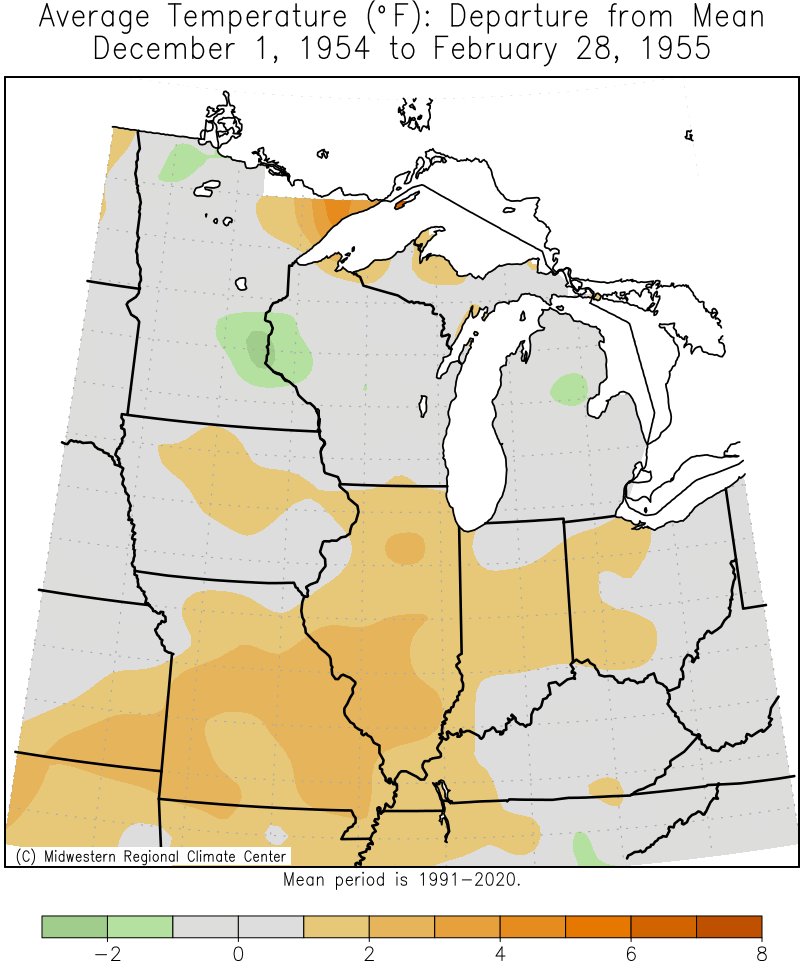 |
 |
 |
| 1949-1950 | 1954-1955 | 1955-1956 | 1964-1965 |
 |
 |
 |
 |
| 1970-1971 | 1971-1972 | 1973-1974 | 1974-1975 |
 |
 |
 |
 |
| 1975-1976 | 1983-1984 | 1984-1985 | 1988-1989 |
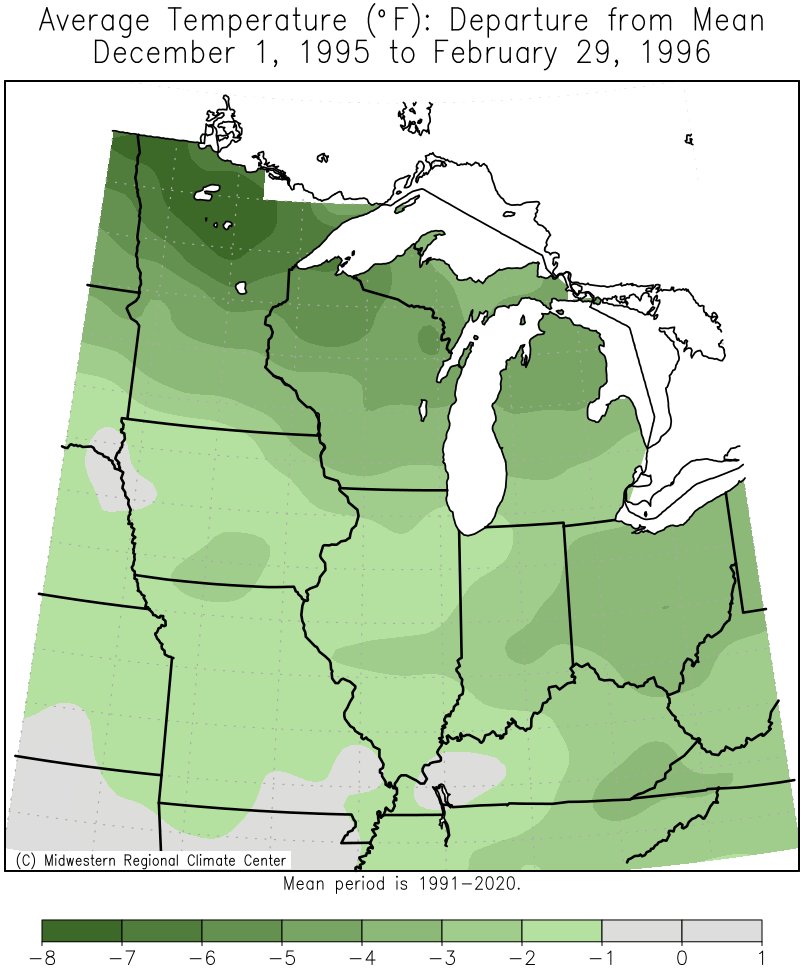 |
 |
 |
 |
| 1995-1996 | 1998-1999 | 1999-2000 | 2000-2001 |
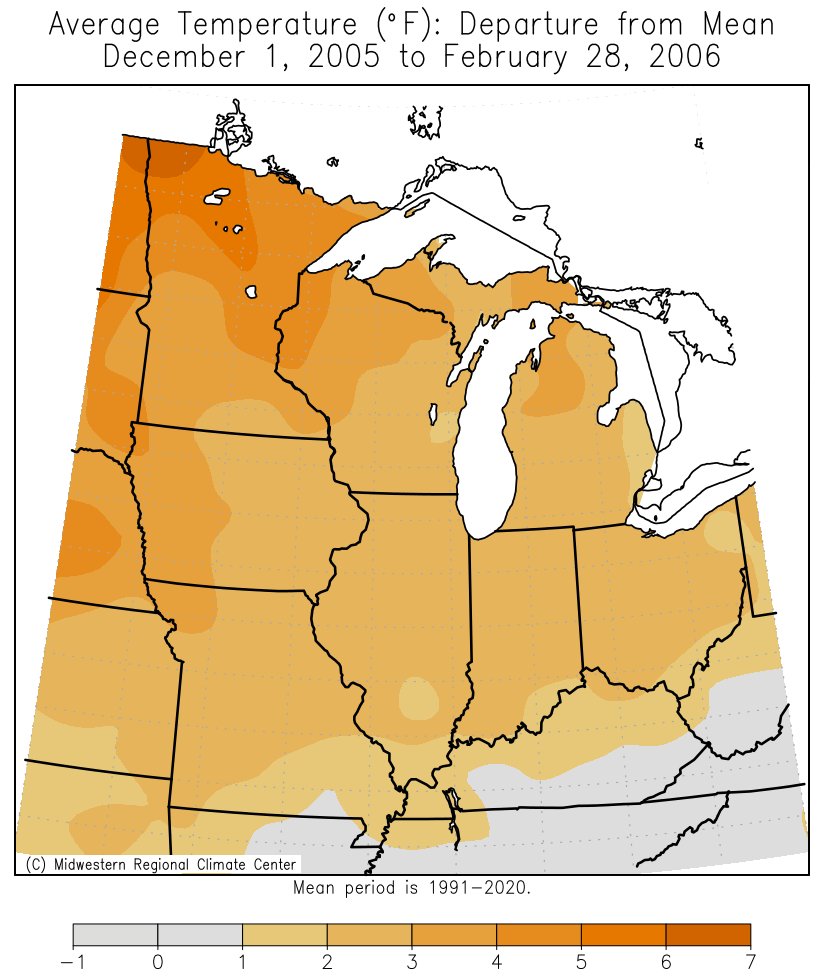 |
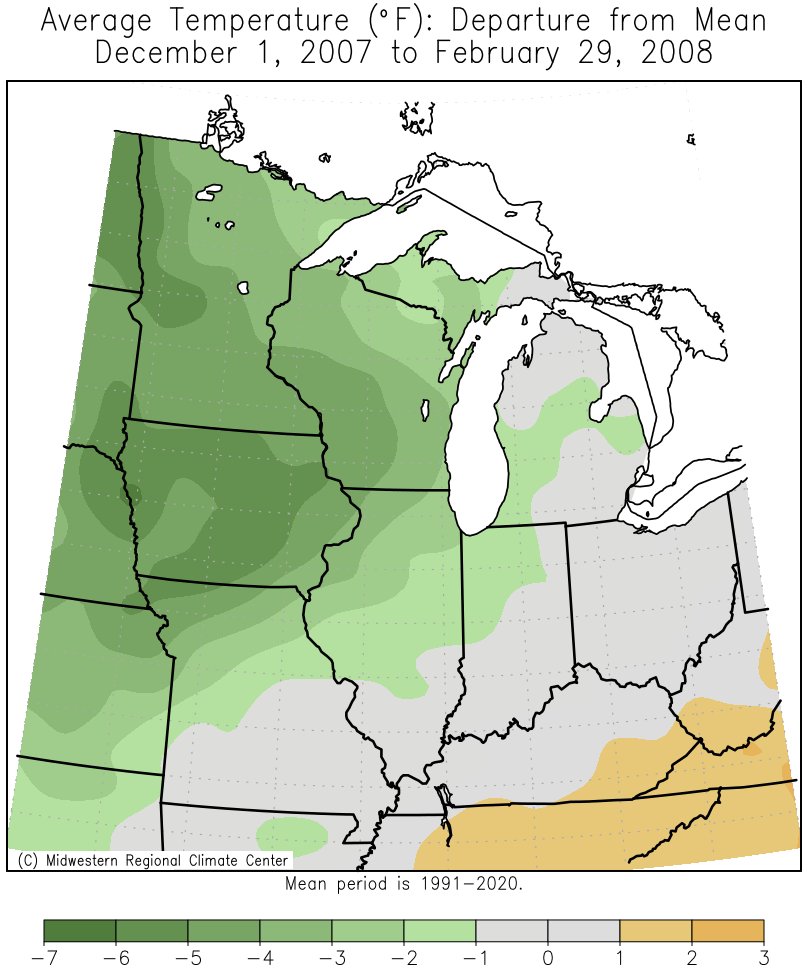 |
 |
 |
| 2005-2006 | 2007-2008 | 2008-2009 | 2010-2011 |
 |
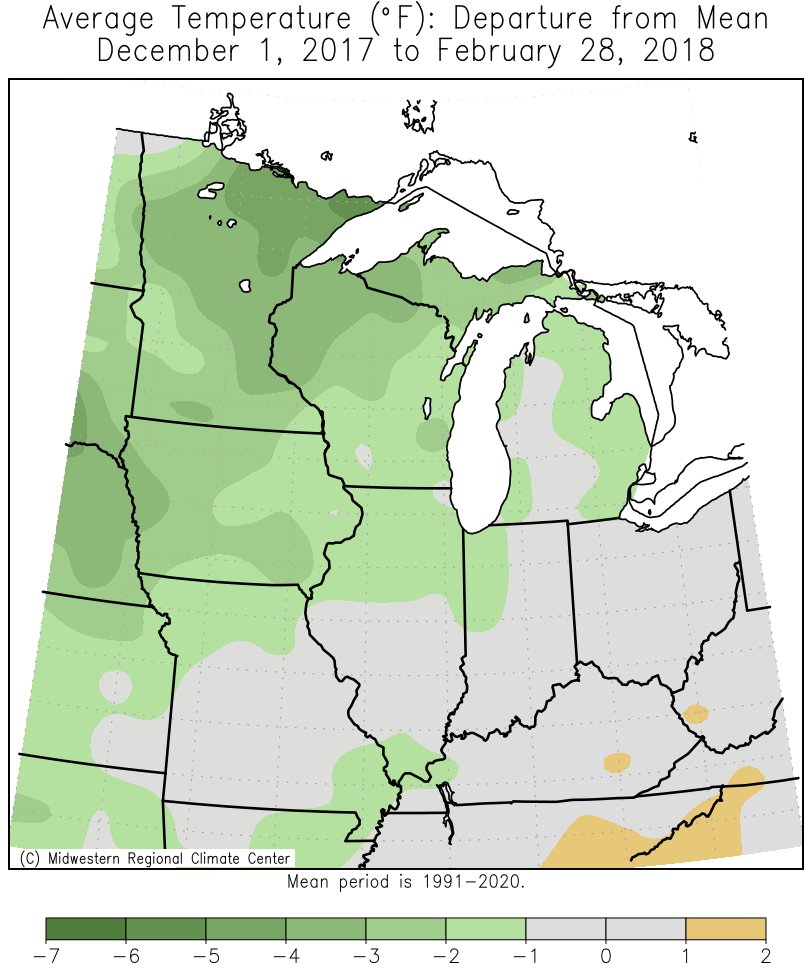 |
 |
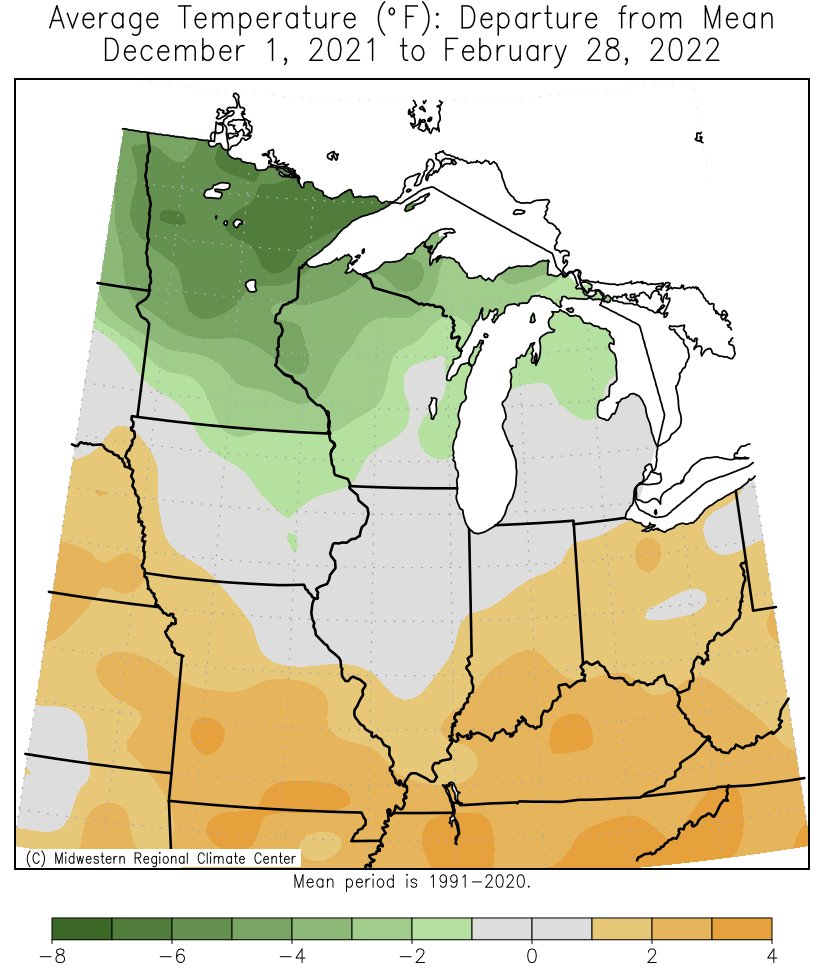 |
| 2011-2012 | 2017-2018 | 2020-2021 | 2021-2022 |
 |
|||
| 2022-2023 |
La Niña Winter Precipitation
Author: Tom Di Liberto (October 12, 2017)
|
When La Niña develops across the tropical central/eastern Pacific Ocean, it can affect areas thousands of miles away, including the United States. The effects are usually strongest in Northern Hemisphere winter. However, no two La Niña winters will have identical precipitation patterns. This series of maps shows precipitation patterns across the continental United States compared to the 1981-2010 average for every winter season—December through February—since 1950 that coincided with La Niña conditions in the equatorial Pacific Ocean. The years are ranked by how far below average the temperatures were in the central/eastern tropical Pacific: strong (at least -1.5° Celsius colder than average), moderate (between -1° and -1.5°C), and weak (between -0.5° and -1°C colder than average). In general, the stronger the La Niña, the more reliable the impacts on the United States. The typical U.S. impacts are warmer- and drier-than-average conditions across the southern tier of the United States, colder-than-average conditions across the north-central Plains, and wetter-than-average conditions in the Ohio Valley and Pacific Northwest/Northern California. However, as is evident in these maps, there is a great deal of variability even among strong La Niña events. And some impacts are more reliable than others. For example, 9 of the 11 strong and moderate events show wetter-than-average conditions in the Pacific Northwest—though the intensity of the anomaly varies—which is most winters, but not all. And 6 of the 11 events produced wet conditions in the Ohio Valley, which is slightly more than half, but far from a guarantee. This “failure” of the typical pattern occurs because La Niña is never the only thing that influences the climate over the United States during the winter. Other climate phenomena, such as the Arctic Oscillation or the Madden Julian Oscillation, as well as the random nature of weather, can also play a large part in how winter turns out. |
Winter (December-February) precipitation during strong, moderate, and weak La Niñas since 1950 (Winter 2017-18 not included) |
Midwest La Niña Winter Winter (DJF) Precipitation Departures (24 Winters since 1949-50)
 |
 |
 |
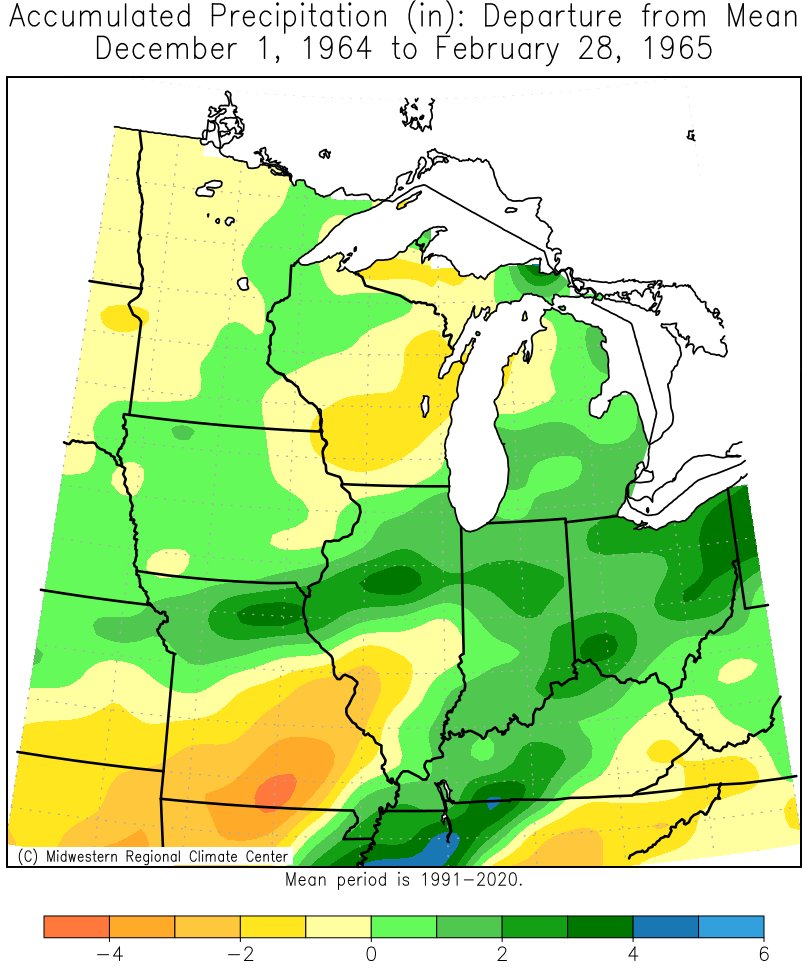 |
| 1949-1950 | 1954-1955 | 1955-1956 | 1964-1965 |
 |
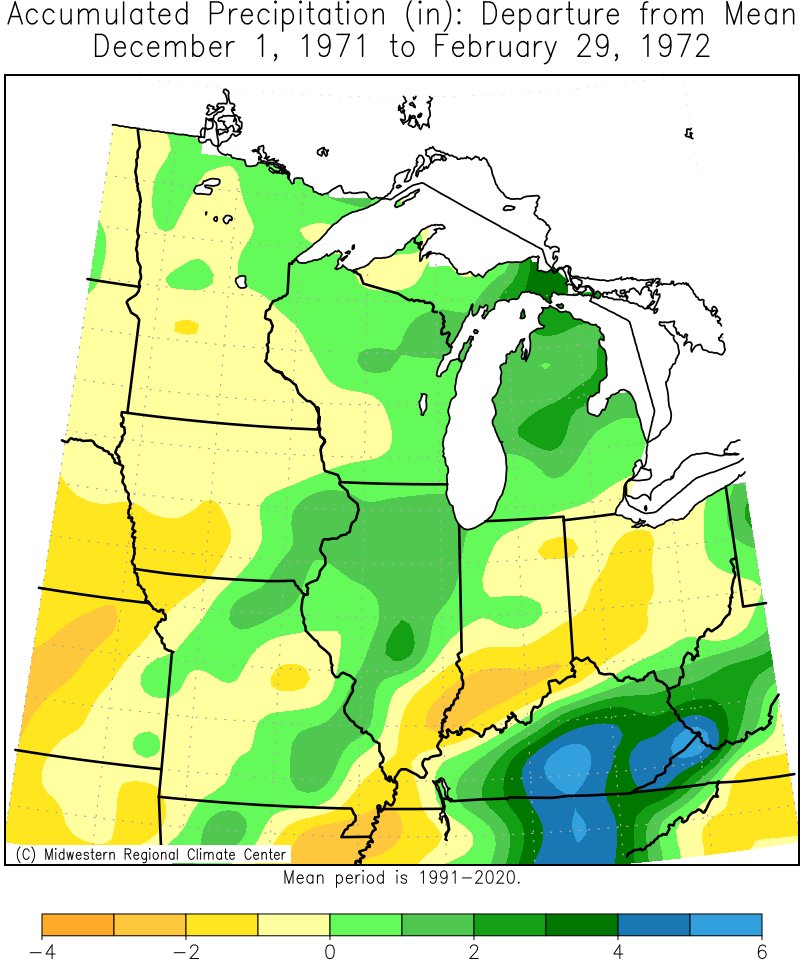 |
 |
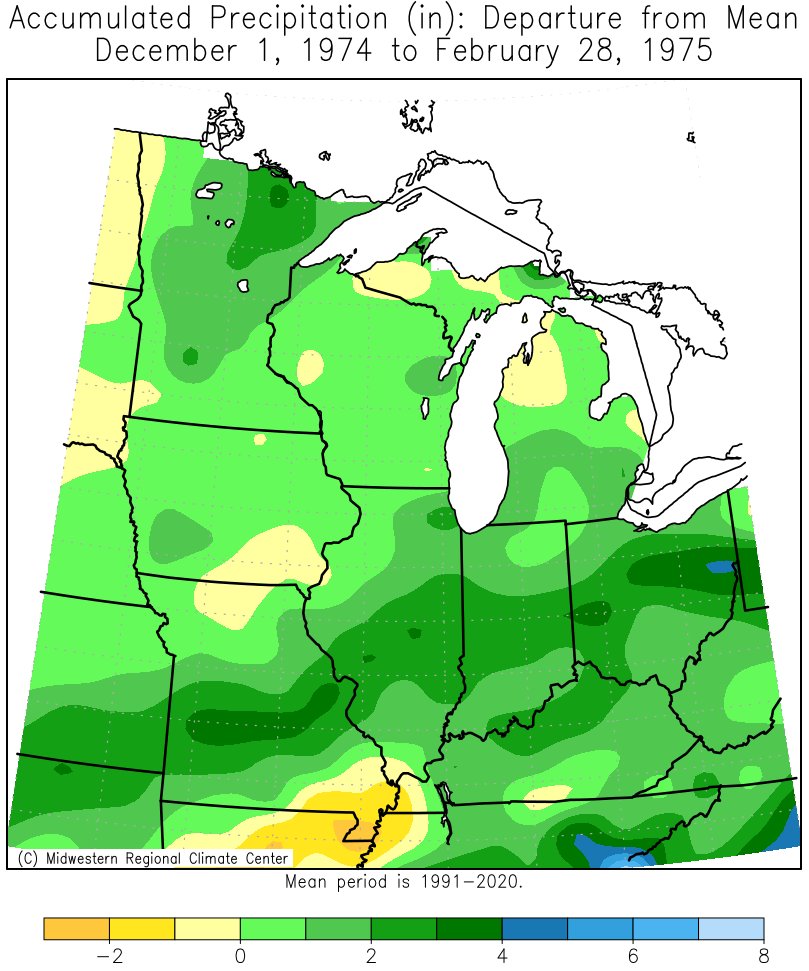 |
| 1970-1971 | 1971-1972 | 1973-1974 | 1974-1975 |
 |
 |
 |
 |
| 1975-1976 | 1983-1984 | 1984-1985 | 1988-1989 |
 |
 |
 |
 |
| 1995-1996 | 1998-1999 | 1999-2000 | 2000-2001 |
 |
 |
 |
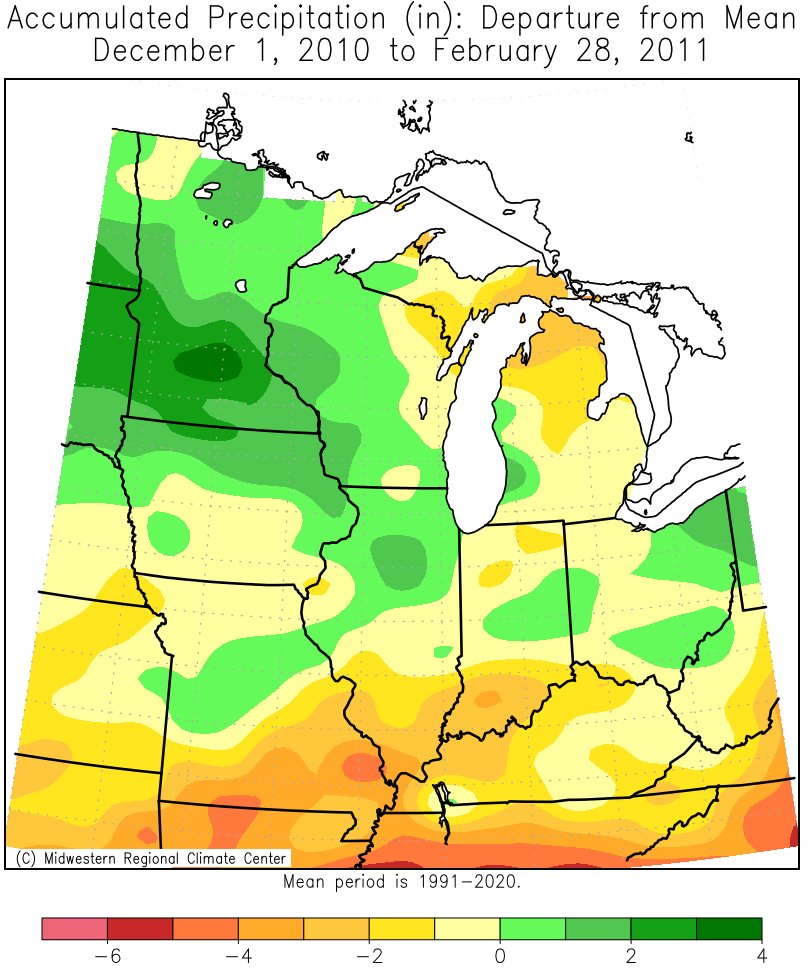 |
| 2005-2006 | 2007-2008 | 2008-2009 | 2010-2011 |
 |
 |
 |
 |
| 2011-2012 | 2017-2018 | 2020-2021 | 2021-2022 |
 |
|||
| 2023-2023 |
La Niña Seasonal Snow
Author: Stephen Baxter (November 21, 2017)
La Niña is associated with a retracted jet stream over the North Pacific Ocean. The retreat of the jet stream results in more blocking high pressure systems that allow colder air to spill into western and central Canada and parts of the northern contiguous U.S. At the same time, storm track activity across the southern tier of the U.S. is diminished under upper-level high pressure, which also favors milder-than-normal temperatures. The storm track is, in turn, shifted northward across parts of the Ohio Valley and Great Lakes (2).
Based on climate analysis (3) from this new snow dataset, we see that La Niña favors increased snowfall over the Northwest and the northern Rockies, as well as in the upper Midwest Great Lakes region. Reduced snowfall is observed over parts of the central-southern Plains, Southwest, and mid-Atlantic.
 Snowfall departure from average for all La Niña winters (1950-2009). Blue shading shows where snowfall is greater than average and brown shows where snowfall is less than average. Climate.gov figure based on analysis at CPC using Rutgers gridded snow data. |
This La Niña footprint is pretty intuitive. Given the northward shift of the storm track, relatively cold and wet conditions are favored over the northern Rockies and northern Plains, resulting in the enhancement of snowfall. Warmer and drier winters are more likely during La Niña over more southern states, and this is exactly where seasonal snowfall tends to be reduced (4). The more vigorous storm track and slight tilt toward colder temperatures over the northern tier of the U.S. during La Niña modestly increase the chance of a relatively snowy winter.
We can break up the snow pattern further and look at the weakest and strongest La Niña events. Splitting La Niña events into strength reveals some interesting differences worth investigating further. In this preliminary analysis below, there is a suggestion that weaker events are snowier over the Northeast and northern and central Plains on average.
|
|
On the other hand, stronger La Niña events (see below) are snowier across the Northwest, the northern Rockies, western Canada, and the Alaska panhandle. Also, there is a tendency toward below-average snowfall over the mid-Atlantic, New England, and northern and central Plains, which is not seen during weak La Niña.
 Snowfall departure from average for stronger La Niña winters (1950-2009). Blue shading shows where snowfall is greater than average and brown shows where snowfall is less than average. Climate.gov figure based on analysis at CPC using Rutgers gridded snow data. |
Overall, stronger La Niña events exert more influence on the winter climate pattern over western North America. Weaker events appear to be associated with more widespread above-average snow over the northern United States. Because a weak La Niña means that the forcing from the Pacific is weaker than normal, it may imply other mechanisms (e.g. Arctic Oscillation) may be at play and is worth further investigation.
The predictability of seasonal snowfall may be somewhat similar to precipitation in that one or two big events can dramatically affect the seasonal average. Thus, in general, the expected prediction skill is likely to be lower than for temperature. However, because temperature also plays an important role in snowfall, some predictability is likely nonetheless. And like for seasonal temperature and precipitation, knowing the state of ENSO is a pretty reasonable place to start.
Midwest La Niña Seasonal Snow Departures (24 Winters since 1949-50)
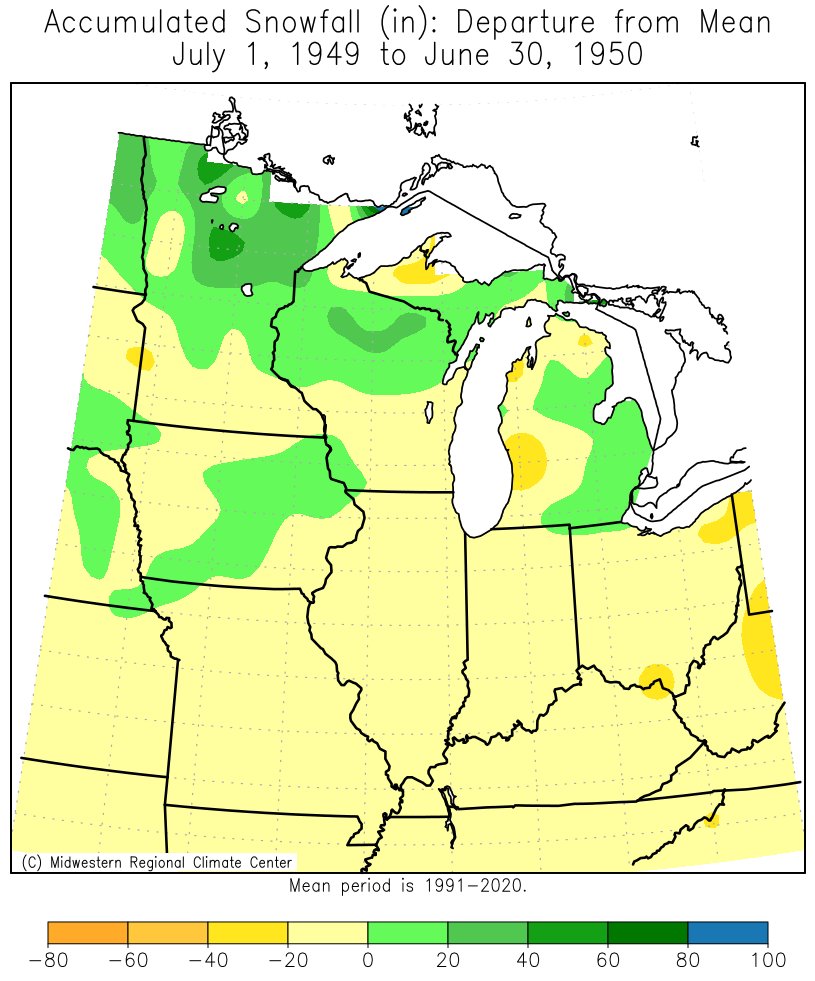 |
 |
 |
 |
| 1949-1950 | 1954-1955 | 1955-1956 | 1964-1965 |
 |
 |
 |
 |
| 1970-1971 | 1971-1972 | 1973-1974 | 1974-1975 |
 |
 |
 |
 |
| 1975-1976 | 1983-1984 | 1984-1985 | 1988-1989 |
 |
 |
 |
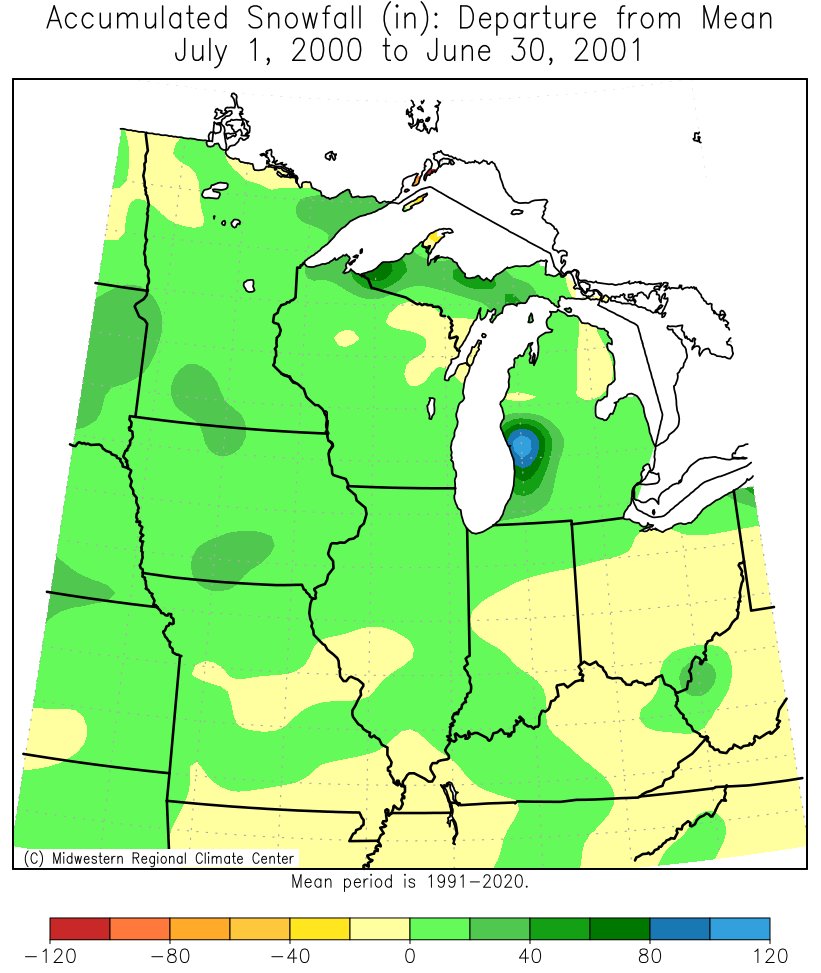 |
| 1995-1996 | 1998-1999 | 1999-2000 | 2000-2001 |
 |
 |
 |
 |
| 2005-2006 | 2007-2008 | 2008-2009 | 2010-2011 |
 |
 |
 |
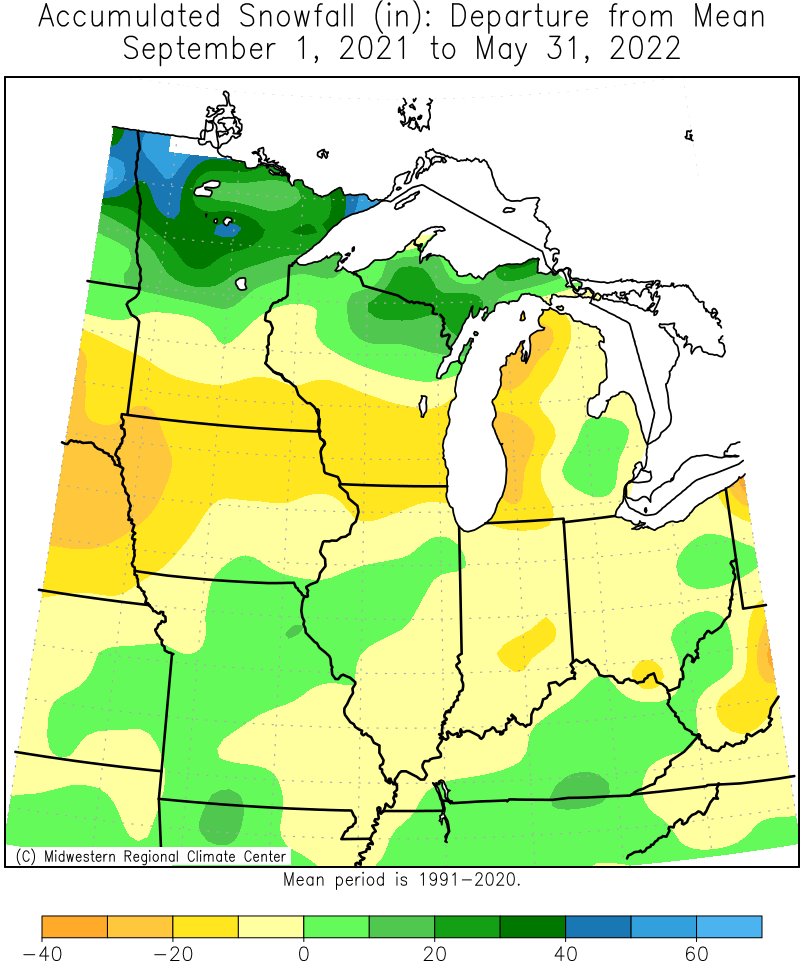 |
| 2011-2012 | 2017-2018 | 2020-2021 | 2021-2022 |
 |
|||
| 2022-2023 |
La Niña AWSSI
Author: Midwestern Regional Climate Center
|
Winter seasons have significant societal impacts across all sectors ranging from direct human health and mortality to commerce, transportation, and education. The question “How severe was this winter?” does not have a simple answer. At the very least, the severity of a winter is related to the intensity and persistence of cold weather, the amount of snow, and the amount and persistence of snow on the ground. The Accumulated Winter Season Severity Index (AWSSI) was developed to objectively quantify and describe the relative severity of the winter season. |
|
Goals of the AWSSI
|
Limitations
|
How does the AWSSI accumulate?
First measurable snowfall (>= 0.1 inch) The winter season ends at the last occurrence of any of the following: Daily scores are calculated based on scores assigned to temperature, snowfall, and snow depth thresholds. The daily scores are accumulated through the winter season, allowing a running total of winter severity in the midst of a season as well as a final, cumulative value characterizing the full season. Accumulations of the temperature and snow components of the index are computed separately and then added together for the total index. This allows a comparison of the relative contribution of each to the total score. The AWSSI has been processed for 52 locations across the continental U.S. to provide a variety of locations in different climate regimes for analysis. The AWSSI is calculated for each season from 1950â€1951 to 2012â€2013. The seasonal data is then subject to quality control, and seasons missing data that would contribute 5% or more of the seasons AWSSI are removed. Averages and standard deviations are calculated for running accumulations of daily temperature and snow scores as well as the total AWSSI. The AWSSI data is gathered every hour throughout the day. Quintiles of AWSSI scores were determined for each location. Descriptive categories were assigned to each quintile as follows:
|
Annotated Scoring Page Sample: |
CONUS AWSSI during La Niña (23 Winters since 1954-55)
 |
 |
 |
 |
| 1954-1955 | 1955-1956 | 1964-1965 | 1970-1971 |
 |
 |
 |
 |
| 1971-1972 | 1973-1974 | 1974-1975 | 1975-1976 |
 |
 |
 |
 |
| 1983-1984 | 1984-1985 | 1988-1989 | 1995-1996 |
 |
 |
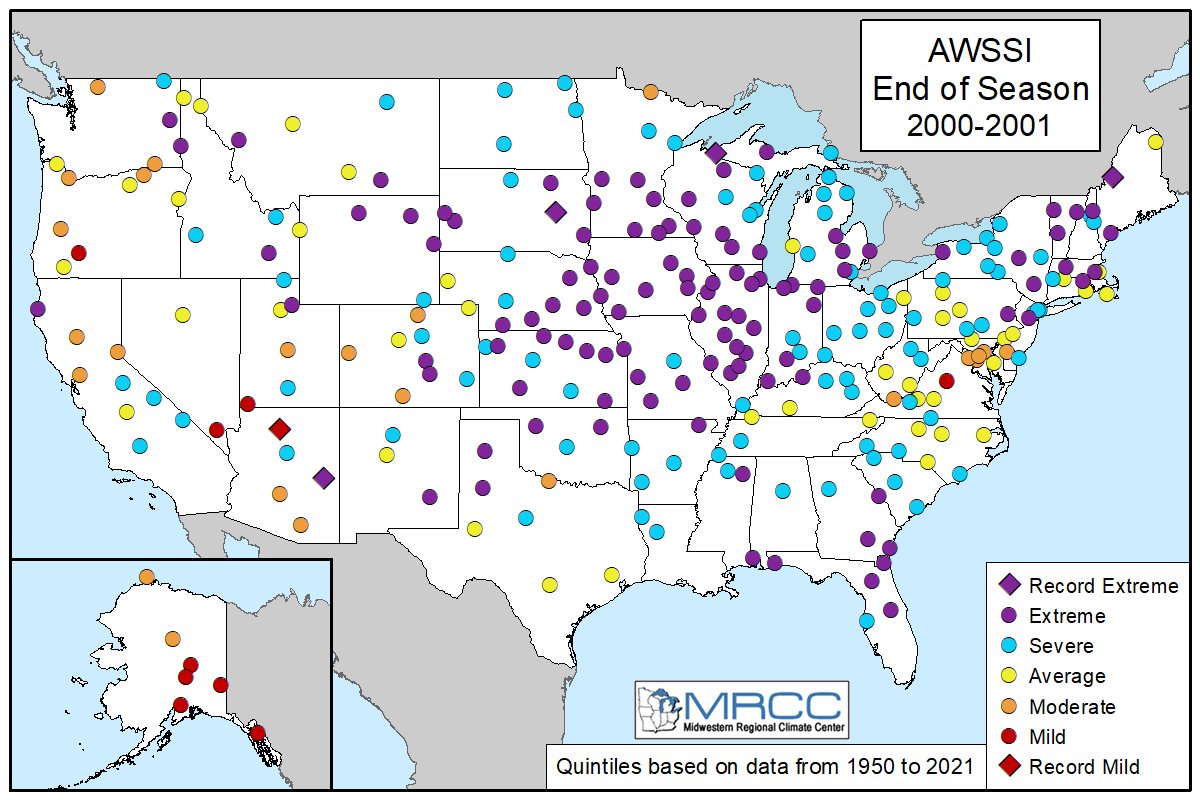 |
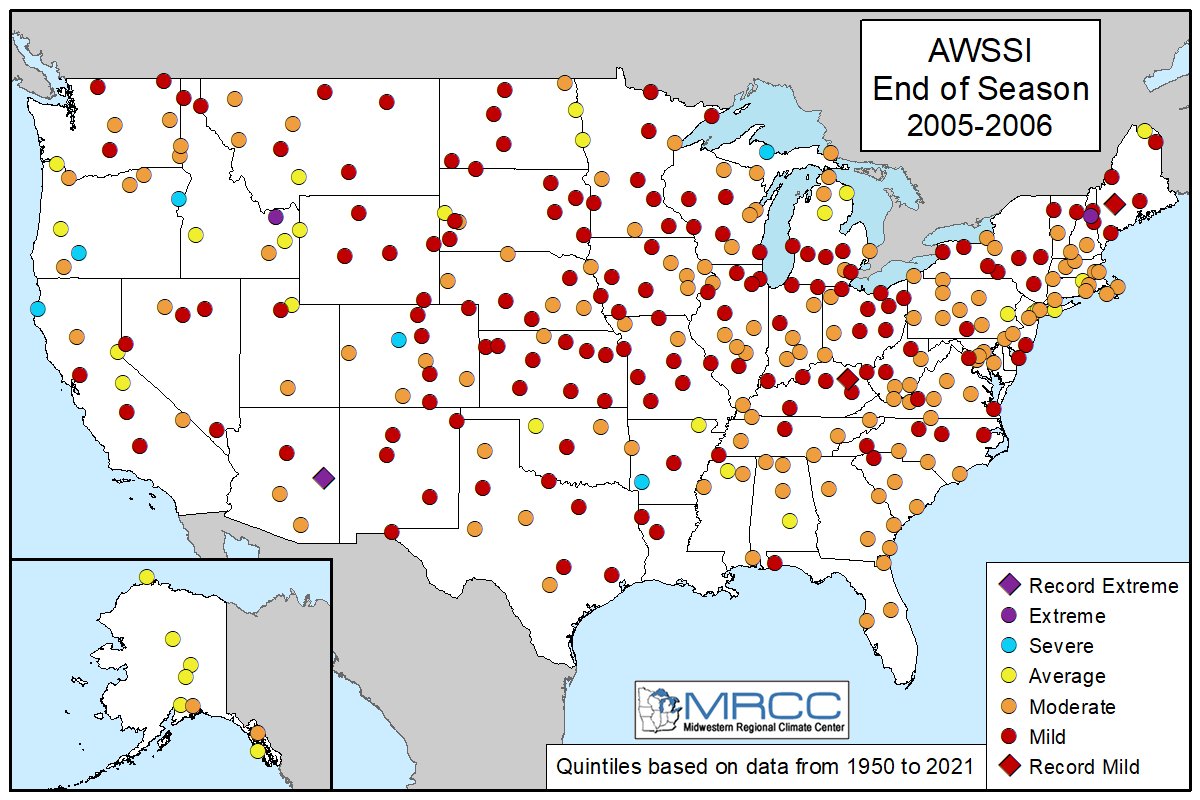 |
| 1998-1999 | 1999-2000 | 2000-2001 | 2005-2006 |
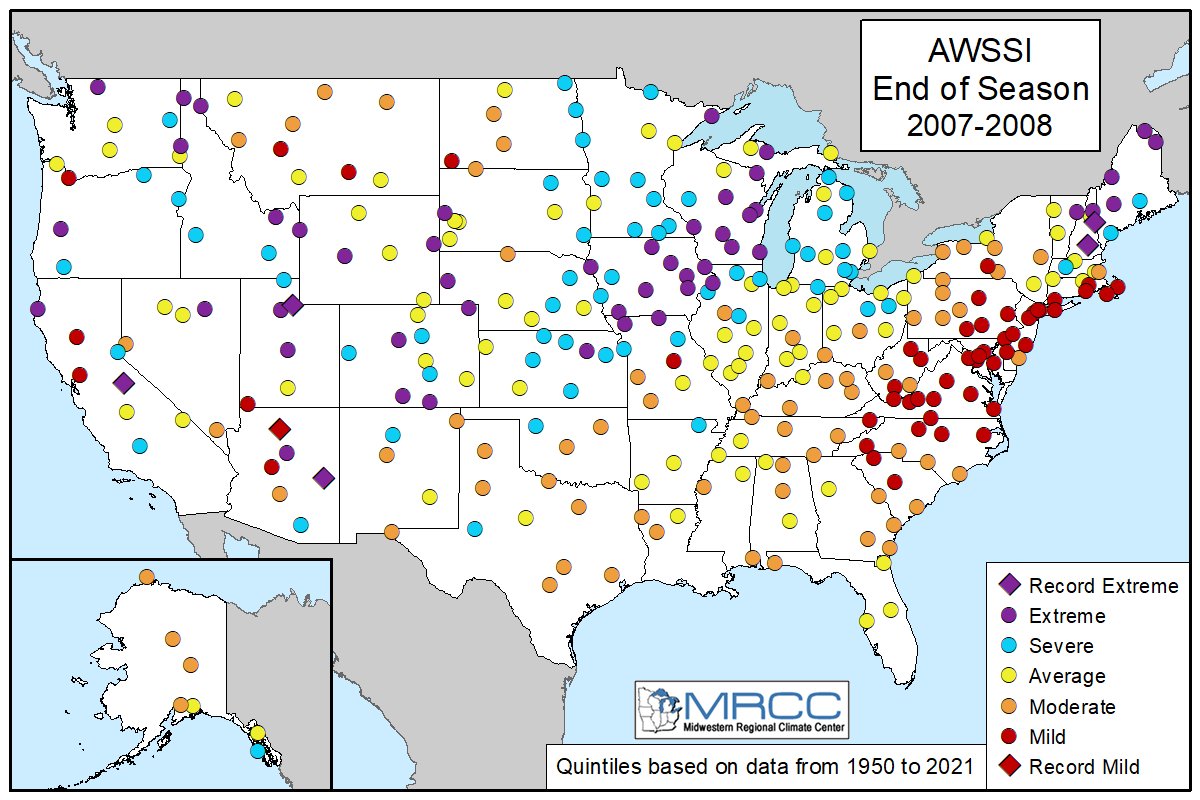 |
 |
 |
 |
| 2007-2008 | 2008-2009 | 2010-2011 | 2011-2012 |
 |
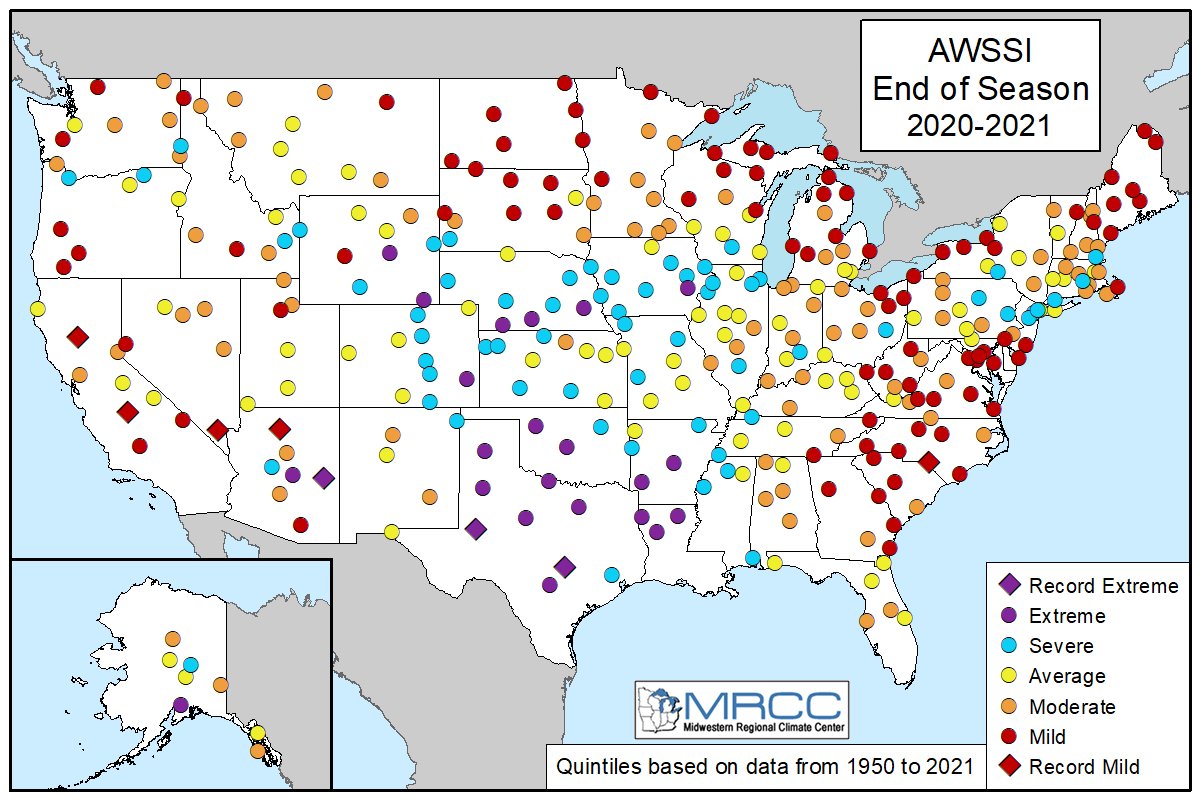 |
 |
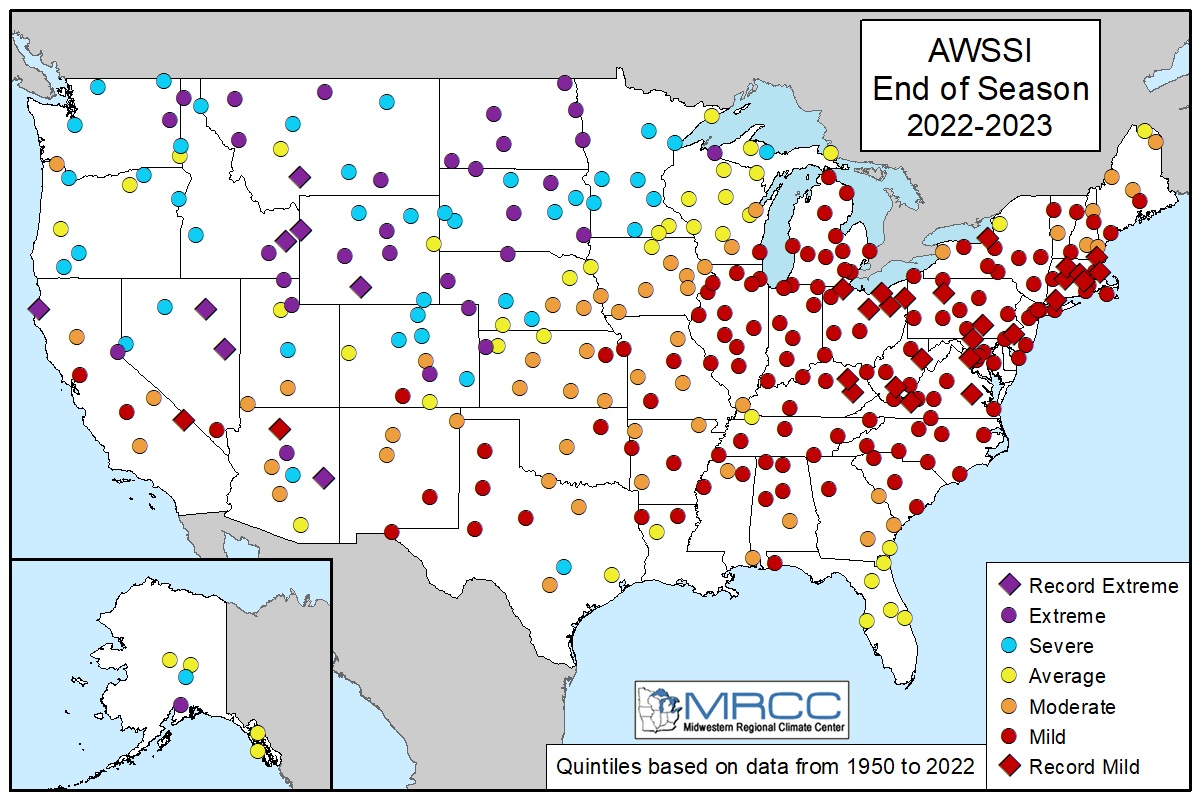 |
| 2017-2018 | 2020-2021 | 2021-2022 | 2022-2023 |
 |
 |
 |
 |
| 1954-1955 | 1955-1956 | 1964-1965 | 1970-1971 |
 |
 |
 |
 |
| 1971-1972 | 1973-1974 | 1974-1975 | 1975-1976 |
 |
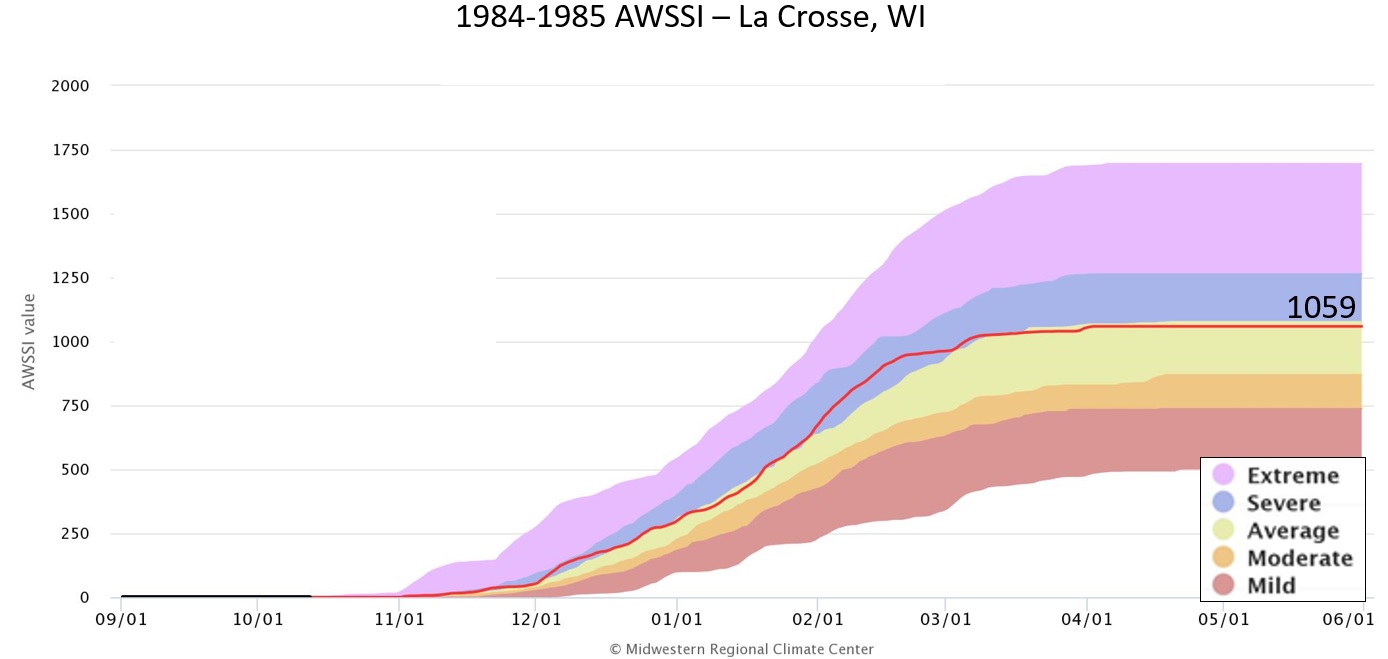 |
 |
 |
| 1983-1984 | 1984-1985 | 1988-1989 | 1995-1996 |
 |
 |
 |
 |
| 1998-1999 | 1999-2000 | 2000-2001 | 2005-2006 |
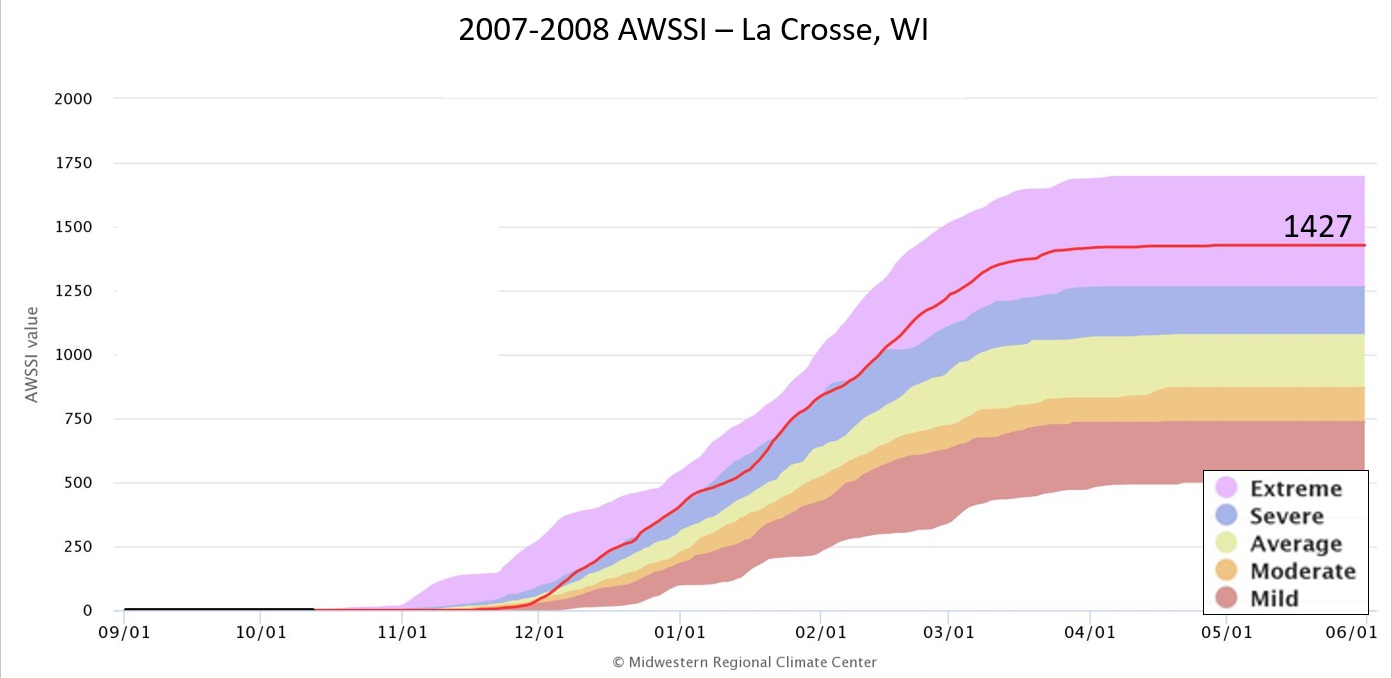 |
 |
 |
 |
| 2007-2008 | 2008-2009 | 2010-2011 | 2011-2012 |
 |
 |
 |
 |
| 2017-2018 | 2020-2021 | 2021-2022 | 2022-2023 |
 |
 |
 |
 |
| 1954-1955 | 1955-1956 | 1964-1965 | 1970-1971 |
 |
 |
 |
 |
| 1971-1972 | 1973-1974 | 1974-1975 | 1975-1976 |
 |
 |
 |
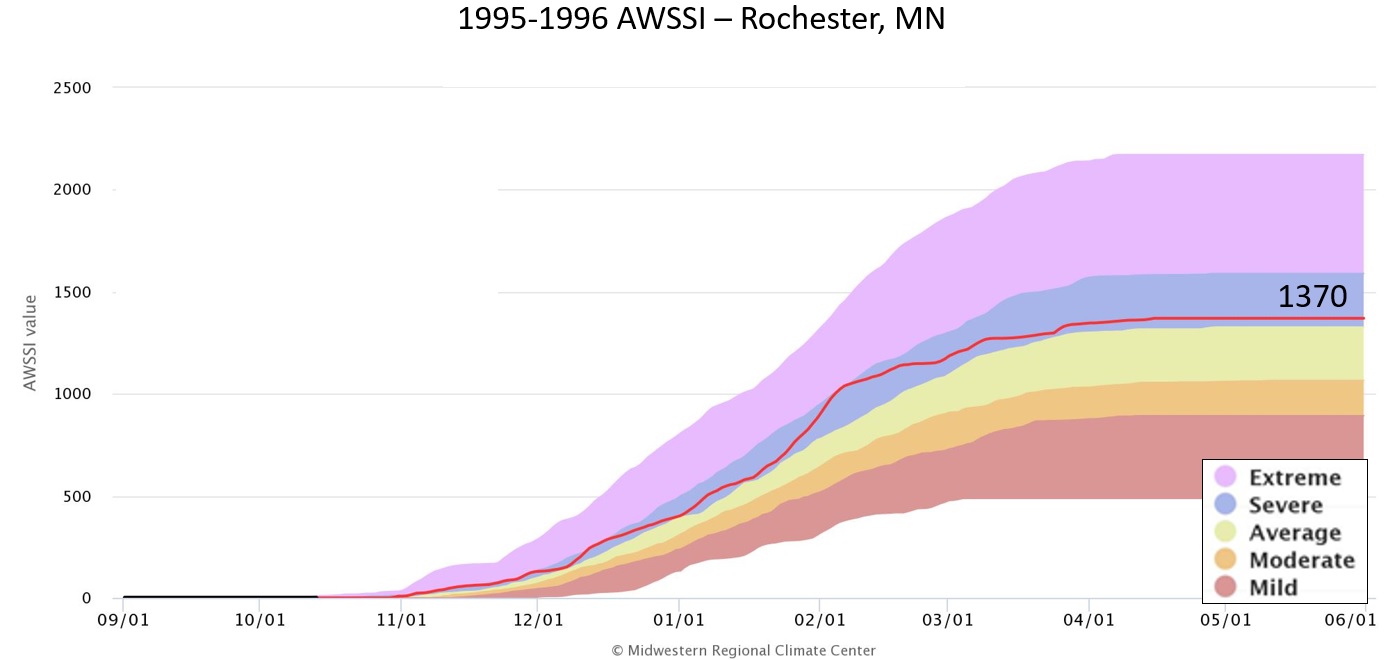 |
| 1983-1984 | 1984-1985 | 1988-1989 | 1995-1996 |
 |
 |
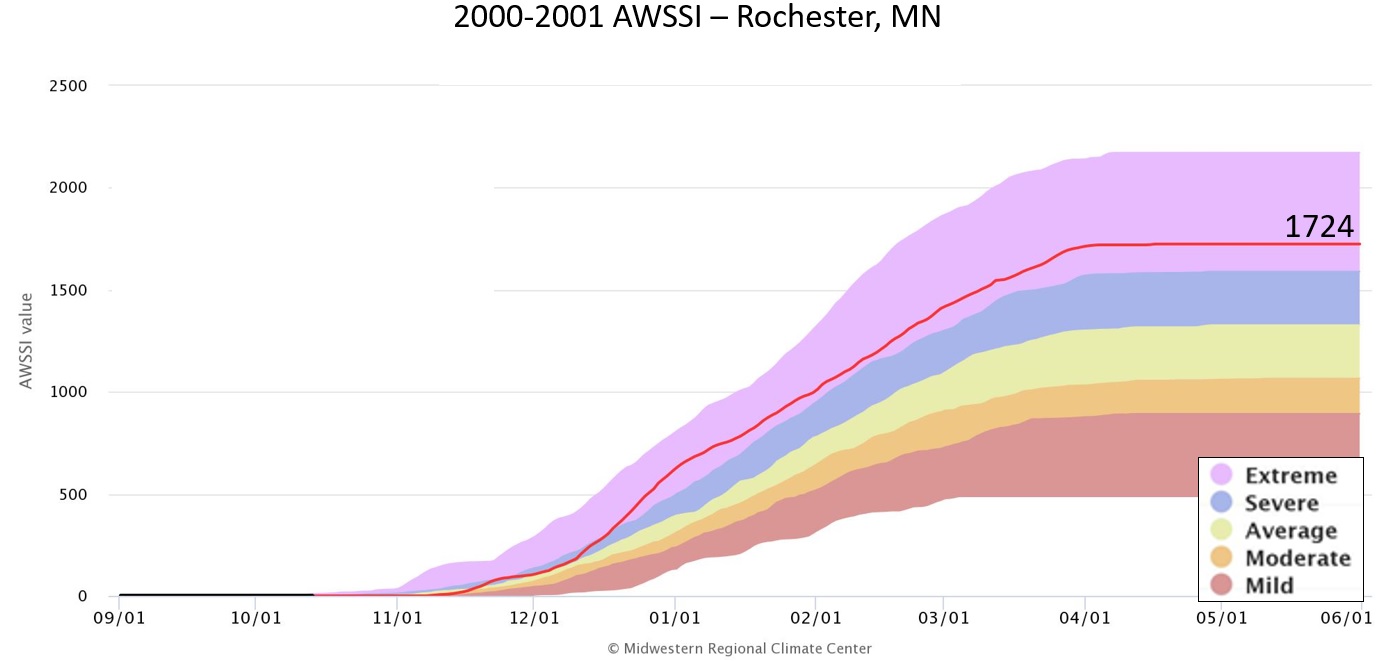 |
 |
| 1998-1999 | 1999-2000 | 2000-2001 | 2005-2006 |
 |
 |
 |
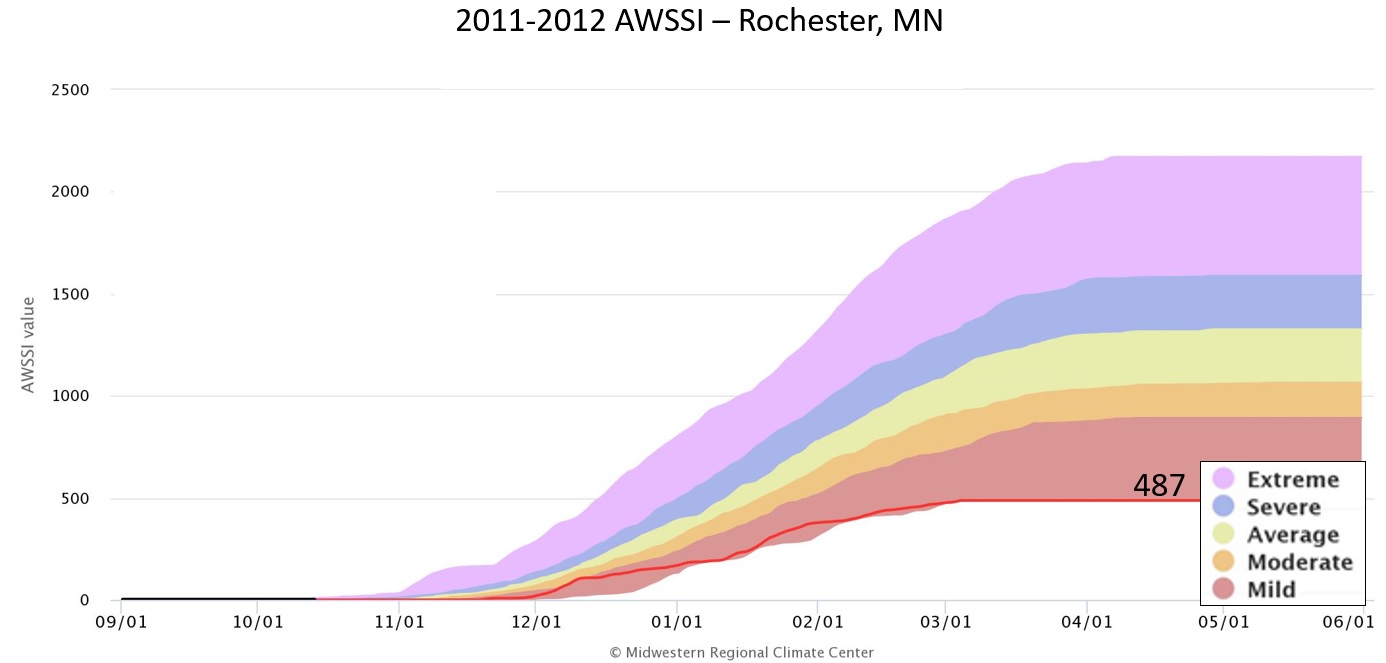 |
| 2007-2008 | 2008-2009 | 2010-2011 | 2011-2012 |
 |
 |
 |
 |
| 2017-2018 | 2020-2021 | 2021-2022 | 2022-2023 |
Information Sheet (2-page) - pdf
The Accumulated Winter Season Severity Index (AWSSI)
Barbara E. Mayes Boustead, Steven D. Hilberg, Martha D. Shulski, and Kenneth G. Hubbard. Journal of Applied Meteorology and Climatology, Vol. 54, No. 8, August 2015: 1693-1712.
Abstract | Full Text | PDF (2545 KB)
An Accumulated Winter Season Severity Index. Barbara Mayes Boustead, NOAA/NWS, Valley, NE; and S. Hilberg, M. D. Shulski, and K. G. Hubbard. Presented at 93rd Annual Meeting of the American Meteorological Society, January 2013.
An Accumulated Winter Season Severity Index (AWSSI). Webinar for the NWS Central Region, February 2017.
For more information, please contact Barb Mayes Boustead (barbara.mayes@noaa.gov) at the National Weather Service or Steve Hilberg (hberg@illinois.edu).
La Niña Severe Weather:
La Niña Severe Weather:
Author: Michael K. Tippett and Chiara Lepore
April 27, 2017
ENSO shifts the atmospheric circulation (notably, the jet stream) in ways that affect winter temperature and precipitation over the U.S. The changes in spring (March-May) are similar to those during winter, but somewhat weaker.
These shifts would also be expected to impact thunderstorm activity: El Niño tends to shift the jet stream farther south over the U.S., which blocks moisture from the Gulf of America, reducing the fuel for thunderstorms. On the other hand, La Niña is associated with a more wavy and northward shifted jet stream, which might be expected to enhance severe weather activity in the south and southeast. Indeed, historic tornado outbreaks in 1974, 2008, and 2011 started during La Niña conditions.
However, tornado and severe weather activity is more variable (“noisier” and harder to predict) than ordinary weather (think temperature and precipitation), and any ENSO signal is harder to see. Until recently, the only solid evidence showing that more tornadoes occur during La Niña conditions was for winter (January-March), when the ENSO signal is strongest, but average tornado activity is relatively low (Cook & Schaefer, 2008).
A clearer picture of the impact of ENSO emerges when we look at the ingredients that are conducive to tornado and thunderstorm occurrence (Allen et al., 2015a). Instead of only looking at individual weather events, it’s important to consider the environmental cues for the outbreak of severe weather.
Two important ingredients for tornadoes are atmospheric instability (e.g., warm, moist air near the surface and cool dry air aloft) and vertical wind shear (winds at different altitudes blowing in different directions or speeds). Measures of these tornado-friendly ingredients can be combined into indexes that are less noisy than actual tornado reports and let us see how the phases of ENSO make the environment more or less favorable for severe weather (footnote 1).
In much of the U.S., La Niña conditions are associated with increases in these environmental factors and in tornado and hail reports. The largest signal is present in the south and southeast (including parts of Texas, Oklahoma, Kansas, Louisiana, Arkansas, and Missouri), except in Florida where the opposite relation is observed. Positive values indicate increased activity, and negative values indicate decreased activity compared to the long-term average (1979-2015).
 |
Figure 1. Sea surface temperature pattern showing the warm phase of the Pacific Decadal Oscillation (top). The status of the PDO between 1950 and this year, shown at bottom, indicates a predominantly positive phase from about 1978 to 1998 and a negative phase since 1999. Image Credit: Climate Impacts Group, University of Washington.
In the South and Southeast, where the signal is strongest, we see a clear shift in activity with the ENSO phase, but with a tremendous range of variability, meaning some El Niño years still have high severe weather activity, and some La Niña years are relatively inactive. While increased tornado activity is generally associated with La Nina conditions, blaming this year’s high activity on the weak La Nina conditions would be exaggerating the strength of the historical relationship (footnote 2).
 |
Regional (100-90W, 31-36N) totals of March-May tornado reports, hail events, a tornado environment index (TEI), and a hail environment index (HEI) expressed as a percentage of their 1979-2015 average and conditioned on the ONI. Box edges mark the 25th and 75th percentiles, and whiskers extend 1 and a half times the interquartile range. Figure by climate.gov; data from the authors.
1: The tornado environment index (TEI) and hail environment index (HEI) are functions of monthly averages of convective precipitation, convective available potential energy, and storm-relative helicity. TEI and HEI are calibrated to match the recent climatology of tornado numbers and hail events. See Tippett et al. (2012) and Allen et al. (2015b) for more details.
2: Inside baseball: Further details of the ENSO relation
Overall, La Nina conditions are associated with enhanced U.S. tornado activity, but more detailed aspects of ENSO may also be relevant (Lee et al., 2012). Gulf of America sea surface temperature is close to the part of the U.S. most strongly impacted by severe weather: warm Gulf of America surface water in spring enhances low-level moisture transport and southerly flow and is associated with enhanced US tornado and hail activity (Molina et al., 2016). The Gulf of America sea surface temperature is negatively correlated with the tropical Pacific sea surface temperature, meaning when the tropical Pacific is cooler than average (La Niña), the Gulf of America is usually warmer than average.
Seasonal (May-July) averages of Gulf of America SST can be predicted with some skill (Jung and Kirtman, 2016). Atmospheric angular momentum is related to ENSO and also shows the impact of tropical forcing on tornado activity (Gensini and Marinaro, 2016).
Local La Niña Statistics:
Past La Niña Winters Statistics for the Local Area:
In the tables below, red represents a value in the upper third of winters, blue represents a value in the lower third of winters, and black represents a near-normal. For La Crosse, the temperature and precipitation data extend back to the 1872-73 winter and snowfall back to 1895-96. For Rochester, the temperature and precipitation data extend back to the 1886-87 winter and snowfall back to 1908-09.
| La Niña Monthly Mean Avg Temperature for La Crosse, WI | ||||
| Year | Dec | Jan | Feb | Season |
| 1949-1950 | 24.6 | 15.7 | 20.6 | 20.3 |
| 1954-1955 | 24.4 | 17.2 | 18.2 | 20.0 |
| 1955-1956 | 15.4 | 15.5 | 17.4 | 16.1 |
| 1964-1965 | 17.4 | 11.0 | 13.9 | 14.1 |
| 1970-1971 | 19.4 | 7.4 | 17.0 | 14.5 |
| 1971-1972 | 24.5 | 11.1 | 16.1 | 17.2 |
| 1973-1974 | 18.9 | 18.0 | 19.1 | 18.6 |
| 1974-1975 | 26.5 | 18.1 | 18.7 | 21.2 |
| 1975-1976 | 23.7 | 13.1 | 29.0 | 21.8 |
| 1983-1984 | 6.4 | 14.1 | 30.3 | 16.6 |
| 1984-1985 | 21.5 | 10.9 | 16.4 | 16.3 |
| 1988-1989 | 21.8 | 24.2 | 12.8 | 19.8 |
| 1995-1996 | 21.0 | 11.9 | 19.9 | 17.5 |
| 1998-1999 | 29.2 | 14.3 | 31.2 | 24.7 |
| 1999-2000 | 27.4 | 18.1 | 30.6 | 25.2 |
| 2000-2001 | 8.6 | 20.6 | 16.3 | 15.1 |
| 2005-2006 | 19.7 | 31.1 | 21.9 | 24.3 |
| 2007-2008 | 19.4 | 14.6 | 14.9 | 16.3 |
| 2008-2009 | 14.1 | 8.8 | 22.8 | 15.0 |
| 2010-2011 | 16.7 | 14.1 | 20.2 | 16.9 |
| 2011-2012 | 28.1 | 23.8 | 29.1 | 27.0 |
| 2017-2018 | 21.9 | 18.8 | 21.0 | 20.6 |
| 2020-2021 | 27.6 | 23.4 | 12.8 | 21.3 |
| 2021-2022 | 28.7 | 12.8 | 18.3 | 19.9 |
| 2022-2023 | 21.5 | 24.4 | 26.1 | 24.0 |
| Dec | Jan | Feb | Season | |
| 1991-2020 Normal | 25.1 | 18.9 | 23.3 | 22.5 |
| La Niña Mean | 21.1 | 16.5 | 20.6 | 19.4 |
| La Niña Max | 29.2 (1998-1999) |
31.1 (2005-2006) |
31.2 (1998-1999) |
27.0 (2011-2012) |
| La Niña Min | 6.4 (1983-1984) |
7.4 (1970-1971) |
12.8 (1988-1989 & 2020-2021) |
14.1 (1964-1965) |
| La Niña Monthly Total Precipitation for La Crosse, WI | ||||
| Year | Dec | Jan | Feb | Season |
| 1949-1950 | 1.20 | 1.34 | 1.43 | 3.97 |
| 1954-1955 | 0.47 | 0.30 | 0.57 | 1.34 |
| 1955-1956 | 0.78 | 0.46 | 0.43 | 1.67 |
| 1964-1965 | 0.86 | 0.81 | 0.72 | 2.39 |
| 1970-1971 | 0.97 | 1.52 | 2.06 | 4.55 |
| 1971-1972 | 2.55 | 0.62 | 0.50 | 3.67 |
| 1973-1974 | 1.37 | 0.40 | 1.65 | 3.42 |
| 1974-1975 | 1.39 | 1.50 | 1.71 | 4.60 |
| 1975-1976 | 0.70 | 0.69 | 0.64 | 2.03 |
| 1983-1984 | 0.68 | 0.28 | 0.92 | 1.88 |
| 1984-1985 | 2.42 | 0.88 | 1.27 | 4.57 |
| 1988-1989 | 0.78 | 0.41 | 0.40 | 1.59 |
| 1995-1996 | 0.82 | 3.03 | 0.41 | 4.26 |
| 1998-1999 | 0.30 | 2.84 | 0.78 | 3.92 |
| 1999-2000 | 0.67 | 1.43 | 0.91 | 3.01 |
| 2000-2001 | 1.90 | 1.19 | 0.99 | 4.08 |
| 2005-2006 | 0.56 | 0.47 | 0.71 | 1.74 |
| 2007-2008 | 2.64 | 1.30 | 1.14 | 5.08 |
| 2008-2009 | 2.32 | 0.74 | 0.97 | 4.03 |
| 2010-2011 | 2.39 | 0.79 | 1.12 | 4.30 |
| 2011-2012 | 1.41 | 1.08 | 1.44 | 3.93 |
| 2017-2018 | 0.53 | 1.38 | 1.22 | 3.13 |
| 2020-2021 | 0.36 | 0.89 | 0.73 | 1.98 |
| 2021-2022 | 1.72 | 0.61 | 0.34 | 2.67 |
| 2022-2023 | 2.38 | 2.17 | 2.19 | 6.74 |
| Dec | Jan | Feb | Season | |
| 1991-2020 Normal | 1.49 | 1.25 | 1.19 | 3.93 |
| La Niña Mean | 1.29 | 1.09 | 1.01 | 3.38 |
| La Niña Max | 2.64 (2007-2008) |
3.03 (1995-1996) |
2.19 (2022-2023) |
6.74 (2022-2023) |
| La Niña Min | 0.30 (1998-1999) |
0.28 (1983-1984) |
0.34 (2021-2022) |
1.34 (1954-1955) |
| Monthly Total Snowfall for La Crosse, WI | ||||||||||
|---|---|---|---|---|---|---|---|---|---|---|
|
Year |
Sep |
Oct |
Nov |
Dec |
Jan |
Feb |
Mar |
Apr |
May |
Season |
| 1949-1950 | 0.0 | 0.0 | 0.0 | 7.5 | 7.0 | 12.7 | 8.1 | 0.2 | 0.0 | 35.5 |
| 1954-1955 | 0.0 | T | 6.7 | 5.3 | 4.8 | 3.3 | 8.8 | T | T | 28.9 |
| 1955-1956 | 0.0 | T | 4.8 | 8.0 | 5.8 | 3.8 | 22.4 | 4.5 | 0.0 | 49.3 |
| 1964-1965 | 0.0 | T | 4.7 | 6.7 | 12.7 | 6.6 | 15.0 | 1.6 | 0.0 | 47.3 |
| 1970-1971 | 0.0 | T | 1.1 | 13.5 | 26.5 | 20.4 | 5.6 | 0.5 | 0.0 | 67.6 |
| 1971-1972 | 0.0 | 0.0 | 3.8 | 12.0 | 10.2 | 8.0 | 11.9 | 3.0 | 0.0 | 48.9 |
| 1973-1974 | 0.0 | 0.0 | T | 9.8 | 2.0 | 14.9 | 7.6 | 0.7 | 0.0 | 35.0 |
| 1974-1975 | T | 0.0 | 2.2 | 10.1 | 18.8 | 20.1 | 18.1 | 3.9 | 0.0 | 73.2 |
| 1975-1976 | 0.0 | 0.0 | 1.7 | 1.0 | 8.0 | 2.7 | 6.0 | 0.0 | T | 19.4 |
| 1983-1984 | 0.0 | 0.0 | 4.0 | 9.2 | 3.5 | 1.7 | 11.0 | T | 0.0 | 29.4 |
| 1984-1985 | 0.0 | T | 2.9 | 13.3 | 9.4 | 5.3 | 14.5 | T | 0.0 | 45.4 |
| 1988-1989 | 0.0 | T | 7.6 | 5.2 | 3.8 | 7.9 | 19.3 | T | T | 43.8 |
| 1995-1996 | 0.0 | 0.5 | 6.1 | 8.8 | 35.0 | 1.2 | 5.8 | 3.3 | 0.0 | 60.7 |
| 1998-1999 | 0.0 | 0.0 | 0.3 | 4.1 | 31.9 | 2.4 | 5.3 | 0.0 | 0.0 | 44.0 |
| 1999-2000 | 0.0 | 0.3 | 0.0 | 4.9 | 9.4 | 5.4 | 3.7 | 1.9 | 0.0 | 25.6 |
| 2000-2001 | 0.0 | T | 2.8 | 25.5 | 4.3 | 6.2 | 8.1 | 0.1 | 0.0 | 47.0 |
| 2005-2006 | 0.0 | 0.0 | 6.1 | 12.9 | 1.6 | 11.4 | 7.8 | T | 0.0 | 39.8 |
| 2007-2008 | 0.0 | 0.0 | 1.7 | 24.2 | 18.3 | 15.0 | 7.9 | 0.8 | 0.0 | 67.9 |
| 2008-2009 | 0.0 | T | 4.0 | 32.7 | 10.1 | 7.7 | 1.2 | T | 0.0 | 55.7 |
| 2010-2011 | 0.0 | 0.0 | T | 32.3 | 11.3 | 10.8 | 5.6 | 4.7 | 0.0 | 64.7 |
| 2011-2012 | 0.0 | T | 0.7 | 4.3 | 13.2 | 2.8 | 0.5 | T | 0.0 | 21.5 |
| 2017-2018 | 0.0 | T | T | 4.4 | 10.8 | 9.5 | 6.1 | 19.0 | 0.0 | 49.8 |
| 2020-2021 | 0.0 | 2.3 | 1.0 | 4.6 | 9.0 | 12.1 | 4.0 | T | 0.0 | 33.0 |
| 2021-2022 | 0.0 | 0.0 | 0.8 | 15.0 | 9.5 | 3.9 | 0.3 | 1.0 | 0.0 | 30.5 |
| 2022-2023 | 0.0 | T | 3.2 | 17.0 | 10.2 | 11.5 | 12.2 | 9.6 | 0.0 | 63.7 |
| Sep | Oct | Nov | Dec | Jan | Feb | Mar | Apr | May | Season | |
| 1991-2020 Normals | 0.0 | 0.3 | 3.4 | 10.9 | 11.8 | 9.7 | 7.3 | 2.9 | 0.0 | 46.3 |
| La Niña Mean | 0.0 | 0.2 | 3.0 | 11.7 | 11.5 | 8.3 | 8.7 | 3.2 | 0.1 | 45.1 |
| La Niña Max | T (1974-1975) |
2.3 (2020-2021) |
7.6 (1988-1989) |
32.7 (2008-2009) |
35.0 (1995-1996) |
20.4 (1970-1971) |
22.4 (1955-1956) |
19.0 (2017-2018) |
T (3 years) |
73.2 (1974-1975) |
| La Niña Min | 0.0 (24 Years) |
0.0 (11 Years) |
0.0 (1949-50 & 1999-2000) |
1.0 (1975-1976) |
1.6 (2005-2006) |
1.2 (1995-1996) |
0.3 (2021-2022) |
0.0 (1975-1976 & 1998-1999) |
0.0 (22 Years) |
19.4 (1975-1976) |
| La Niña Monthly Mean Avg Temperature for Rochester, MN | ||||
|---|---|---|---|---|
|
Year |
Dec |
Jan |
Feb |
Season |
| 1949-1950 | 20.9 | 10.3 | 14.3 | 15.2 |
| 1954-1955 | 22.4 | 14.6 | 15.2 | 17.5 |
| 1955-1956 | 12.8 | 12.4 | 13.1 | 12.7 |
| 1964-1965 | 15.4 | 9.7 | 11.6 | 12.2 |
| 1970-1971 | 18.0 | 5.8 | 16.4 | 13.3 |
| 1971-1972 | 20.0 | 6.5 | 12.4 | 13.0 |
| 1973-1974 | 14.8 | 12.8 | 15.8 | 14.4 |
| 1974-1975 | 22.3 | 14.6 | 15.4 | 17.5 |
| 1975-1976 | 22.5 | 12.7 | 28.2 | 21.0 |
| 1983-1984 | 2.9 | 12.4 | 25.4 | 13.3 |
| 1984-1985 | 19.1 | 10.2 | 14.8 | 14.7 |
| 1988-1989 | 19.2 | 21.7 | 9.3 | 17.0 |
| 1995-1996 | 18.1 | 9.6 | 17.0 | 14.9 |
| 1998-1999 | 25.0 | 11.1 | 26.6 | 20.7 |
| 1999-2000 | 23.5 | 14.4 | 26.3 | 21.3 |
| 2000-2001 | 6.1 | 17.4 | 11.2 | 11.6 |
| 2005-2006 | 17.2 | 28.1 | 19.6 | 21.7 |
| 2007-2008 | 17.0 | 12.8 | 13.3 | 14.4 |
| 2008-2009 | 12.5 | 8.5 | 20.7 | 13.7 |
| 2010-2011 | 14.7 | 11.4 | 18.0 | 14.6 |
| 2011-2012 | 26.1 | 22.8 | 27.7 | 25.5 |
| 2017-2018 | 17.9 | 14.6 | 15.3 | 16.0 |
| 2020-2021 | 24.7 | 20.7 | 8.3 | 17.9 |
| 2021-2022 | 24.9 | 9.4 | 13.9 | 16.1 |
| 2022-2023 | 17.2 | 19.3 | 19.9 | 18.8 |
| Dec | Jan | Feb | Season | |
| 1991-2020 Normals | 20.8 | 14.7 | 18.7 | 18.1 |
| La Niña Mean | 18.2 | 13.8 | 17.2 | 16.4 |
| La Niña Max | 26.1 (2011-2012) |
28.1 (2005-2006) |
28.2 (1975-1976) |
25.5 (2011-2012) |
| La Niña Min | 2.9 (1983-1984) |
5.8 (1970-1971) |
8.3 (2020-2021) |
11.6 (2000-2001) |
| La Niña Monthly Total Precipitation for Rochester, MN | ||||
|---|---|---|---|---|
|
Year |
Dec |
Jan |
Feb |
Season |
| 1949-1950 | 0.73 | 1.55 | 1.33 | 3.61 |
| 1954-1955 | 0.56 | 0.40 | 1.14 | 2.10 |
| 1955-1956 | 1.23 | 0.57 | 0.52 | 2.32 |
| 1964-1965 | 0.84 | 0.45 | 1.34 | 2.63 |
| 1970-1971 | 0.82 | 1.12 | 2.21 | 4.15 |
| 1971-1972 | 0.98 | 0.71 | 0.29 | 1.98 |
| 1973-1974 | 0.99 | 0.36 | 0.73 | 2.08 |
| 1974-1975 | 0.56 | 1.91 | 0.76 | 3.23 |
| 1975-1976 | 1.21 | 0.38 | 0.49 | 2.08 |
| 1983-1984 | 1.00 | 0.11 | 1.96 | 3.07 |
| 1984-1985 | 1.79 | 0.63 | 0.57 | 2.99 |
| 1988-1989 | 1.11 | 0.41 | 0.42 | 1.94 |
| 1995-1996 | 0.62 | 2.00 | 0.18 | 2.80 |
| 1998-1999 | 0.28 | 2.07 | 1.13 | 3.48 |
| 1999-2000 | 0.49 | 1.30 | 0.45 | 2.24 |
| 2000-2001 | 1.64 | 0.91 | 1.06 | 3.61 |
| 2005-2006 | 0.59 | 0.30 | 0.40 | 1.29 |
| 2007-2008 | 1.21 | 0.67 | 0.56 | 2.44 |
| 2008-2009 | 1.52 | 0.64 | 0.79 | 2.95 |
| 2010-2011 | 3.68 | 0.84 | 0.77 | 5.29 |
| 2011-2012 | 1.21 | 0.57 | 1.63 | 3.41 |
| 2017-2018 | 0.51 | 1.42 | 1.08 | 3.01 |
| 2020-2021 | 0.20 | 1.14 | 0.65 | 1.99 |
| 2021-2022 | 1.41 | 0.83 | 0.41 | 2.65 |
| 2022-2023 | 1.62 | 2.41 | 2.54 | 6.57 |
| Dec | Jan | Feb | Season | |
| 1991-2020 Normals | 1.28 | 0.99 | 1.02 | 3.29 |
| La Niña Mean | 1.07 | 0.95 | 0.94 | 2.96 |
| La Niña Max | 3.68 (2010-2011) |
2.41 (2022-2023) |
2.54 (2022-2023) |
6.57 (2022-2023) |
| La Niña Min | 0.20 (2020-2021) |
0.11 (1983-84) |
0.18 (1995-96) |
1.29 (2005-06) |
| Monthly Total Snowfall for Rochester, MN | ||||||||||
| Season | Sep | Oct | Nov | Dec | Jan | Feb | Mar | Apr | May | Season |
| 1949-1950 | 0.0 | T | 4.9 | 4.7 | 14.4 | 14.9 | 11.8 | 0.4 | T | 51.1 |
| 1954-1955 | 0.0 | 0.8 | 7.2 | 5.2 | 4.6 | 4.7 | 7.3 | T | 0.0 | 29.8 |
| 1955-1956 | 0.0 | 0.7 | 4.3 | 17.4 | 5.7 | 5.7 | 18.8 | 7.4 | 0.0 | 60.0 |
| 1964-1965 | 0.0 | T | 4.8 | 6.4 | 11.1 | 8.8 | 12.2 | 5.2 | T | 48.5 |
| 1970-1971 | 0.0 | 0.1 | 7.6 | 10.8 | 16.2 | 16.0 | 9.7 | 1.6 | 0.0 | 62.0 |
| 1971-1972 | 0.0 | 0.0 | 7.8 | 8.4 | 11.0 | 3.5 | 7.8 | 2.7 | 0.0 | 41.2 |
| 1973-1974 | 0.0 | T | 0.3 | 16.3 | 2.1 | 12.3 | 11.2 | 0.3 | 0.0 | 42.5 |
| 1974-1975 | 0.0 | 0.0 | 2.9 | 8.3 | 14.1 | 10.2 | 15.0 | 2.5 | 0.0 | 53.0 |
| 1975-1976 | 0.0 | T | 7.8 | 1.9 | 6.6 | 1.6 | 10.3 | T | 0.2 | 28.4 |
| 1983-1984 | 0.0 | T | 14.0 | 16.2 | 2.7 | 12.0 | 16.1 | 5.0 | 0.0 | 66.0 |
| 1984-1985 | 0.0 | T | 3.7 | 14.4 | 12.2 | 9.3 | 25.2 | 3.8 | 0.0 | 68.6 |
| 1988-1989 | 0.0 | T | 10.8 | 4.8 | 4.7 | 9.3 | 21.2 | 0.1 | 0.2 | 51.1 |
| 1995-1996 | T | 2.3 | 4.0 | 11.8 | 30.2 | 1.9 | 9.3 | 2.1 | 0.0 | 61.6 |
| 1998-1999 | 0.0 | 0.0 | 0.7 | 5.3 | 29.4 | 5.4 | 6.7 | T | 0.0 | 47.5 |
| 1999-2000 | 0.0 | 0.5 | T | 7.6 | 19.3 | 7.0 | 3.3 | 2.1 | 0.0 | 39.8 |
| 2000-2001 | 0.0 | T | 5.4 | 35.3 | 7.3 | 7.4 | 10.2 | T | 0.0 | 65.6 |
| 2005-2006 | 0.0 | 0.0 | 5.5 | 12.1 | 0.8 | 8.2 | 11.1 | 0.0 | 0.0 | 37.7 |
| 2007-2008 | 0.0 | 0.0 | 0.9 | 13.1 | 13.0 | 7.3 | 9.0 | 0.8 | T | 44.1 |
| 2008-2009 | 0.0 | 0.1 | 4.4 | 28.6 | 9.8 | 8.0 | 1.2 | 0.6 | 0.0 | 52.7 |
| 2010-2011 | 0.0 | 0.0 | 1.3 | 41.3 | 9.8 | 9.3 | 4.6 | 4.2 | T | 70.5 |
| 2011-2012 | 0.0 | T | 0.2 | 8.4 | 8.1 | 3.9 | T | T | 0.0 | 20.6 |
| 2017-2018 | 0.0 | 2.6 | 0.7 | 7.2 | 16.2 | 9.5 | 7.0 | 17.0 | 0.0 | 60.2 |
| 2020-2021 | 0.0 | 4.2 | 4.4 | 3.9 | 11.6 | 8.7 | 8.9 | T | 0.0 | 41.7 |
| 2021-2022 | 0.0 | 0.0 | 0.6 | 13.1 | 8.7 | 6.4 | 0.6 | 0.9 | 0.0 | 30.3 |
| 2022-2023 | 0.0 | 0.1 | 6.4 | 18.3 | 11.5 | 13.6 | 10.3 | 4.2 | 0.0 | 64.4 |
| Sep | Oct | Nov | Dec | Jan | Feb | Mar | Apr | May | Season | |
| 1991-2020 Normals | 0.0 | 0.9 | 4.5 | 12.4 | 12.2 | 10.7 | 8.6 | 3.3 | 0.5 | 53.1 |
| La Niña Mean | 0.0 | 0.7 | 4.6 | 12.8 | 11.2 | 8.2 | 10.4 | 3.2 | 0.0 | 49.6 |
| La Niña Max | T (1995-1996) |
4.2 (2020-2021) |
14.0 (1983-1984) |
41.3 (2010-2011) |
30.2 (1995-1996) |
16.0 (1970-1971) |
25.2 (1984-1985) |
17.0 (2017-2018) |
0.2 (1975-1976 & 1988-1989) |
70.5 (2010-2011) |
| La Niña Min | 0.0 (24 Years) |
0.0 (8 Years) |
T (1999-2000) |
1.9 (1975-1976) |
0.8 (2005-2006) |
1.6 (1975-1976) |
T (2010-2011) |
0.0 (2005-2006) |
0.0 (19 Years) |
20.6 (2011-2012) |
Arctic Oscillation:
Climate Variability: Arctic Oscillation (AO)
Author: LuAnn Dahlman
August 30, 2009
The Arctic Oscillation (AO) refers to an atmospheric circulation pattern over the mid-to-high latitudes of the Northern Hemisphere. The most obvious reflection of the phase of this oscillation is the north-to-south location of the storm-steering, mid-latitude jet stream. Thus, the AO can have a strong influence on weather and climate in major population centers in North America, Europe, and Asia, especially during winter.
The AO's positive phase is characterized by lower-than-average air pressure over the Arctic paired with higher-than-average pressure over the northern Pacific and Atlantic Oceans. The jet stream is farther north than average under these conditions, and storms can be shifted northward of their usual paths. Thus, the mid-latitudes of North America, Europe, Siberia, and East Asia generally see fewer cold air outbreaks than usual during the positive phase of the AO.
Conversely, AO's negative phase has higher-than-average air pressure over the Arctic region and lower-than-average pressure over the northern Pacific and Atlantic Oceans. The jet stream shifts toward the equator under these conditions, so the globe-encircling river of air is south of its average position. Consequently, locations in the mid-latitudes are more likely to experience outbreaks of frigid, polar air during winters when the AO is negative. In New England, for example, higher frequencies of coastal storms known as "Nor'easters" are linked to AO's negative phase.
 This graph shows monthly values for the Arctic Oscillation index. |
AO phases are analogous to the Southern Hemisphere's Antarctic Oscillation (AAO), a similar pattern of air pressure and jet stream anomalies in the Southern Hemisphere. Viewed from above either pole, these patterns show a characteristic ring-shape or "annular" pattern; thus, AO and AAO are also referred to as the Northern Annular Mode (NAM) and Southern Annular Mode (SAM), respectively.
Monthly and Daily values for the Arctic Oscillation Index are available from NOAA's Climate Prediction Center.
References
Thompson, D.W.J., S. Lee, and M.P. Baldwin, 2002: Atmospheric Processes Governing the Northern Hemisphere Annular Mode/North Atlantic Oscillation. From the AGU monograph on the North Atlantic Oscillation, 293, 85-89.
Thompson, D.W.J., and J.M. Wallace, 2001: Regional Climate Impacts of the Northern Hemisphere Annular Mode. Science, 293, 85-89.
Thompson, D.W.J., and J.M. Wallace, 2000: Annular modes in the extratropical circulation. Part I: Month-to-month variability. J. Climate, 13, 1000-1016.
Thompson, D.W.J., and J.M. Wallace 1998: The Arctic Oscillation signature in wintertime geopotential height and temperature fields. Geophys. Res. Lett. 25, 1297-1300.
Madden Julian Oscillation:
Climate Variability: Madden-Julian Oscillation (MJO)
Author: Jon Gottschalck
December 31, 2014
While the Madden-Julian Oscillation (MJO) is a lesser-known phenomenon, it can have dramatic impacts in the mid-latitudes. Several times a year the MJO is a strong contributor to various extreme events in the United States, including Arctic air outbreaks during the winter months across the central and eastern portions of the United States.
Imagine ENSO as a person riding a stationary exercise bike in the middle of a stage all day long. His unchanging location is associated with the persistent changes in tropical rainfall and winds that we have previously described as being linked to ENSO. Now imagine another bike rider entering the stage on the left and pedaling slowly across the stage, passing the stationary bike (ENSO), and exiting the stage at the right. This bike rider we will call the MJO and he/she may cross the stage from left to right several times during the show.
So, unlike ENSO, which is stationary, the MJO is an eastward moving disturbance of clouds, rainfall, winds, and pressure that traverses the planet in the tropics and returns to its initial starting point in 30 to 60 days, on average. This atmospheric disturbance is distinct from ENSO, which once established, is associated with persistent features that last several seasons or longer over the Pacific Ocean basin. There can be multiple MJO events within a season, and so the MJO is best described as intraseasonal tropical climate variability (i.e. varies on a week-to-week basis).
The MJO was first discovered in the early 1970s by Dr. Roland Madden and Dr. Paul Julian when they were studying tropical wind and pressure patterns. They often noticed regular oscillations in winds (as defined from departures from average) between Singapore and Canton Island in the west-central equatorial Pacific (Madden and Julian, 1971; 1972; Zhang, 2005).
The MJO consists of two parts, or phases: one is the enhanced rainfall (or convective) phase and the other is the suppressed rainfall phase. Strong MJO activity often dissects the planet into halves: one half within the enhanced convective phase and the other half in the suppressed convective phase. These two phases produce opposite changes in clouds and rainfall and this entire dipole (i.e., having two main opposing centers of action) propagates eastward. The location of the convective phases is often grouped into geographically based stages that climate scientists number 1-8 as shown in Figure 1.
 |
Figure 1: Difference from average rainfall for all MJO events from 1979-2012 for November-March for the eight phases described in the text. The green shading denotes above-average rainfall, and the brown shading shows below-average rainfall. To first order, the green shading areas correspond to the extent of the enhanced convective phase of the MJO and the brown shading areas correspond to the extent of the suppressed convective phase of the MJO. Note eastward shifting of shaded areas with each successive numbered phase as you view the figure from top to bottom.
For the MJO to be considered active, this dipole of enhanced/suppressed convective phases must be present and shifting eastward with time. An animated illustration that depicts the global scale and eastward propagation of these two phases of the MJO is shown here (Fig. 2: animation).
 |
Figure 2. An animation illustrating the organization of the MJO into its enhanced and suppressed convective phases during an MJO event during the spring of 2005. The green shading denotes conditions favorable for large-scale enhanced rainfall, and the brown shading shows conditions unfavorable for rainfall. The MJO becomes organized during late March through May as the green shading covers one half of the planet, and brown shades the other half all along as these areas move west to east with time. Notice how the shading returns to the same location on the order of about 45 days.
Let’s dig a little deeper and look at some of the characteristics within these two convective phases (Figure 3). In the enhanced convective phase, winds at the surface converge, and the air is pushed up throughout the atmosphere. At the top of the atmosphere, the winds reverse (i.e., diverge). Such rising air motion in the atmosphere tends to increase condensation and rainfall.
 |
Figure3: The surface and upper-atmosphere structure of the MJO for a period when the enhanced convective phase (thunderstorm cloud) is centered across the Indian Ocean and the suppressed convective phase is centered over the west-central Pacific Ocean. Horizontal arrows pointing left represent wind departures from average that are easterly, and arrows pointing right represent wind departures from average that are westerly. The entire system shifts eastward over time, eventually circling the globe and returning to its point of origin. Climate.gov drawing by Fiona Martin.
In the suppressed convective phase, winds converge at the top of the atmosphere, forcing air to sink and, later, to diverge at the surface (Rui and Wang, 1990). As air sinks from high altitudes, it warms and dries, which suppresses rainfall.
It is this entire dipole structure, illustrated in Figure 3, that moves west to east with time in the Tropics, causing more cloudiness, rainfall, and even storminess in the enhanced convective phase, and more sunshine and dryness in the suppressed convective phase.
The changes in rainfall and winds described above impact both the Tropics and the Extratropics, which makes the MJO important for extended-range weather and climate prediction over the U.S. and many other areas. The MJO can modulate the timing and strength of monsoons (e.g., Jones and Carvalho, 2002; Lavender and Matthews, 2009), influence tropical cyclone numbers and strength in nearly all ocean basins (e.g., Maloney and Hartmann, 2000), and result in jet stream changes that can lead to cold air outbreaks, extreme heat events, and flooding rains over the United States and North America (Higgins et al. 2000, Cassou, 2008, Lin et al. 2009, Zhou et al., 2012, Riddle et al., 2013, Johnson et al., 2014).
The MJO can produce impacts similar to those of ENSO, but which appear only in weekly averages before changing, rather than persisting and therefore appearing in seasonal averages as is the case for ENSO.
Future posts will focus on the details of how we monitor and assess the strength of the MJO, provide details on impacts and the reasons for those impacts, and describe the current state of MJO predictability. Realtime MJO information that is updated daily or weekly can be found on the NOAA CPC MJO webpage.
Madden R. and P. Julian, 1971: Detection of a 40-50 day oscillation in the zonal wind in the tropical Pacific, J. Atmos. Sci., 28, 702-708.
Madden R. and P. Julian, 1972: Description of global-scale circulation cells in the tropics with a 40-50 day period. J. Atmos. Sci., 29, 1109-1123.
Cassou, C., 2008: Intraseasonal interaction between the Madden Julian Oscillation and the North Atlantic Oscillation. Nature, 455, 523-527 doi:10.1038/nature07286 Letter
Higgins, W., J. Schemm, W. Shi, and A. Leetmaa, 2000: Extreme precipitation events in the western United States related to tropical forcing. J. Climate, 13, 793-820.
Nathaniel C. Johnson, Dan C. Collins, Steven B. Feldstein, Michelle L. L’Heureux, and Emily E. Riddle, 2014: Skillful Wintertime North American Temperature Forecasts out to 4 Weeks Based on the State of ENSO and the MJO*. Wea. Forecasting, 29, 23–38.
Jones, C. and L. Carvalho, 2002: Active and Break phases in the South American Monsoon System. J. Climate, 15, 905-914.
Lavender, S. and A. Matthews, 2009: Response of the West African monsoon to the Madden-Julian Oscillation, J. Climate, 22, 4097-4116.
Maloney E. and D. Hartmann, 2000: Modulation of hurricane activity in the Gulf of America by the Madden-Julian Oscillation. Science, 287, 2002-2004.
Riddle, E. E., M. B. Stoner, N. C. Johnson, M. L. L’Heureux, D. C. Collins, and S. B. Feldstein, 2013: The impact of the MJO on clusters of wintertime circulation anomalies over the North American region. Climate Dyn., 40, 1749–1766.
Zhang, C., 2005: Madden-Julian Oscillation. Reviews of Geophysics, 43, 1-36.
Zhou S., M. L’Heureux, S. Weaver, and A. Kumar, 2012: A composite study of MJO influence on the surface air temperature and precipitation over the Continental United States. Climate Dyn., 38, 1459-1471.
North Atlantic Oscillation:
Climate Variability: North Atlantic Oscillation (NAO)
The North Atlantic Oscillation (NAO) index is based on the surface sea-level pressure difference between the Subtropical (Azores) High and the Subpolar Low. The positive phase of the NAO reflects below-normal heights and pressure across the high latitudes of the North Atlantic and above-normal heights and pressure over the central North Atlantic, the eastern United States and western Europe. The negative phase reflects an opposite pattern of height and pressure anomalies over these regions. Both phases of the NAO are associated with basin-wide changes in the intensity and location of the North Atlantic jet stream and storm track, and in large-scale modulations of the normal patterns of zonal and meridional heat and moisture transport, which in turn results in changes in temperature and precipitation patterns often extending from eastern North America to western and central Europe.
During particularly prolonged periods dominated by one particular phase of the NAO, abnormal height and temperature patterns are also often seen extending well into central Russia and north-central Siberia.
The NAO exhibits considerable interseasonal and interannual variability, and prolonged periods (several months) of both positive and negative phases of the pattern are common.
The NAO index is obtained by projecting the NAO loading pattern to the daily anomaly 500 millibar height field over 0-90°N. The NAO loading pattern has been chosen as the first mode of a Rotated Empirical Orthogonal Function (EOF) analysis using monthly mean 500 millibar height anomaly data from 1950 to 2000 over 0-90°N latitude.
 |
For more information, please visit the NCEI and Climate Prediction Center NAO pages.
Past Winters:
Below are the temperature, precipitation, and snow data for La Crosse, WI, and Rochester, MN.
|
|
||||||||||||||||||||||||||||||||||||||||||||||||||||||||||||||||||||||||||||||||||||||||||||||||||||||||||||||||||||||||||||||||||||||||||||||||||||||||||||||||||||||||||||||||||||||||||||||||||||||||||||||||||||||||||||||||||||||||||||||||||||||||||||||||||||||||||||||||||||||||||||||||||||||||||||||||||||||||||||||||||||||||||||||||||||||||||||||||||||||||||||||||||||||||||||||||||||||||||||||||||||||||||||||||||||||||||||||||||||||||||||||||||||||||||||||||||||||||||||||||||||||||||||||||||||||||||||||||||||||||||||||||||||||||||||||||||||||||||||||||||||||||||||||||||||||||||||||||||||||||||||||||||||||||||||||||||||||||||||||||||||||||||||||||||||||||||||||||||||||||||||||||||||||||||||||||||||||||||||||||||||||||||||||||||||||||||||||||||||||||||||||||||||||||||||||||||||||||||||||||||||||||||||||||||||||||||||||||||||||||||||||||||||||||||||||||||||||||||||||||||||||||||||||||||||||||||||||||||||||||||||||||||||||||||||||||||||||||||||||||||||||||||||||||||||||||||||||||||||||
|
|||||||||||||||||||||||||||||||||||||||||||||||||||||||||||||||||||||||||||||||||||||||||||||||||||||||||||||||||||||||||||||||||||||||||||||||||||||||||||||||||||||||||||||||||||||||||||||||||||||||||||||||||||||||||||||||||||||||||||||||||||||||||||||||||||||||||||||||||||||||||||||||||||||||||||||||||||||||||||||||||||||||||||||||||||||||||||||||||||||||||||||||||||||||||||||||||||||||||||||||||||||||||||||||||||||||||||||||||||||||||||||||||||||||||||||||||||||||||||||||||||||||||||||||||||||||||||||||||||||||||||||||||||||||||||||||||||||||||||||||||||||||||||||||||||||||||||||||||||||||||||||||||||||||||||||||||||||||||||||||||||||||||||||||||||||||||||||||||||||||||||||||||||||||||||||||||||||||||||||||||||||||||||||||||||||||||||||||||||||||||||||||||||||||||||||||||||||||||||||||||||||||||||||||||||||||||||||||||||||||||||||||||||||||||||||||||||||||||||||||||||||||||||||||||||||||||||||||||||||||||||||||||||||||||||||||||||||||||||||||||||||||||||||||||||||||||||||||||||||||
|
|
||||||||||||||||||||||||||||||||||||||||||||||||||||||||||||||||||||||||||||||||||||||||||||||||||||||||||||||||||||||||||||||||||||||||||||||||||||||||||||||||||||||||||||||||||||||||||||||||||||||||||||||||||||||||||||||||||||||||||||||||||||||||||||||||||||||||||||||||||||||||||||||||||||||||||||||||||||||||||||||||||||||||||||||||||||||||||||||||||||||||||||||||||||||||||||||||||||||||||||||||||||||||||||||||||||||||||||||||||||||||||||||||||||||||||||||||||||||||||||||||||||||||||||||||||||||||||||||||||||||||||||||||||||||||||||||||||||||||||||||||||||||||||||||||||||||||||||||||||||||||||||||||||||||||||||||||||||||||||||||||||||||||||||||||||||||||||||||||||||||||||||||||||||||||||||||||||||||||||||||||||||||||||||||||||||||||||||||||||||||||||||||||||||||||||||||||||||||||||||||||||||||||||||||||||||||||||||||||||||||||||||||||||||||||||||||||||||||||||||||||||||||||||||||||||||||||||||||||||||||||||||||||||||||||||||||||||||||||||||||||||||||||||||||||||||||||||||||||||||||
|
|||||||||||||||||||||||||||||||||||||||||||||||||||||||||||||||||||||||||||||||||||||||||||||||||||||||||||||||||||||||||||||||||||||||||||||||||||||||||||||||||||||||||||||||||||||||||||||||||||||||||||||||||||||||||||||||||||||||||||||||||||||||||||||||||||||||||||||||||||||||||||||||||||||||||||||||||||||||||||||||||||||||||||||||||||||||||||||||||||||||||||||||||||||||||||||||||||||||||||||||||||||||||||||||||||||||||||||||||||||||||||||||||||||||||||||||||||||||||||||||||||||||||||||||||||||||||||||||||||||||||||||||||||||||||||||||||||||||||||||||||||||||||||||||||||||||||||||||||||||||||||||||||||||||||||||||||||||||||||||||||||||||||||||||||||||||||||||||||||||||||||||||||||||||||||||||||||||||||||||||||||||||||||||||||||||||||||||||||||||||||||||||||||||||||||||||||||||||||||||||||||||||||||||||||||||||||||||||||||||||||||||||||||||||||||||||||||||||||||||||||||||||||||||||||||||||||||||||||||||||||||||||||||||||||||||||||||||||||||||||||||||||||||||||||||||||||||||||||||||||
| Caption (source) |
Caption (source) |
Caption (source) |
Caption (source) |
 |
Media use of NWS Web News Stories is encouraged! Please acknowledge the NWS as the source of any news information accessed from this site. |
 |